This flight is actually the first segment of an FB award ticket to Indonesia which owes a lot to a patient Flying Blue staff who understood my needs, whom I thank publicly (but anonymously). I may eventually translate the whole series of FR, now being posted in French, but you will have to be patient.
The story of the construction of this award ticket also owes a lot:
- to FB's website which is unavailable when you need it

- to FB's website which does not let you order an open jaw ticket (there is a menu for that, but it gets you nowhere)
- to FB's website which does not let you order a ticket paid in airmiles from an account for the way in, and from another for the return trip
- to embargo dates that a rank and file PAX cannot guess
- to erroneous changes of airmiles fees, once the file was set
- to an erroneous 0 checked luggage allowance, once the file was set
- to 29'30, then 19'30 phone calls to a number which would have been surcharged, if I had not made the call look like if it came from abroad.
The purpose of using airmiles for this vacation was to use those of my wife before they expired, using mine to complete the fare, a transaction which was much too complicated for FB's programmers. I had initially planned to use all of her airmiles for one of the tickets, buying airmiles to reach the required amount, but the price of FB's airmiles has skyrocketed: I remembered it used to be 10 EUR/ 1,000 miles, but it is now 53 EUR / 1,000 miles, an inflation which ridicules that of the award fees for business / first class tickets.
Ten months pass by, with AF e-mails now and then informing me of a schedule change of ten minutes for this or that flight, with negligible impact. Yes indeed, this ticket had been booked a looong time ahead, because award tickets quickly drain for that destination at that season, at least on the CDG-NRT segment.
There are very few twin seats in economy in an AF 77W, and none were available, event that far in advance. Out of kindness to my wife who wants to be able to move around during long haul flights, I forfeited a chance to have a window seat. I could have had one, even when I checked in on line, but then she would had a middle seat (no good to move around), or she would have sat away from me (no good in a couple). Siberia's landscape is not very exciting, it was going to be a night flight in part, and concessions are part of married life. I chose us two seats in the rear, not the last row whose seats do not recline.
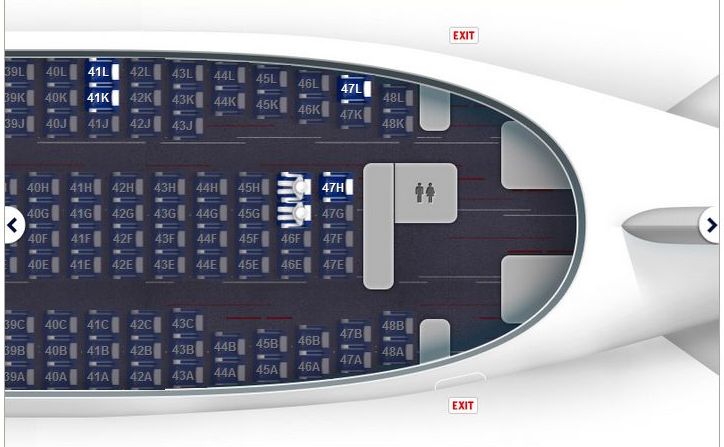
The journey started on D Day in the train to CDG. Bad luck: that train was a multiple unit, one renovated, the other not, and it was the old one which stopped in front of us on the platform.
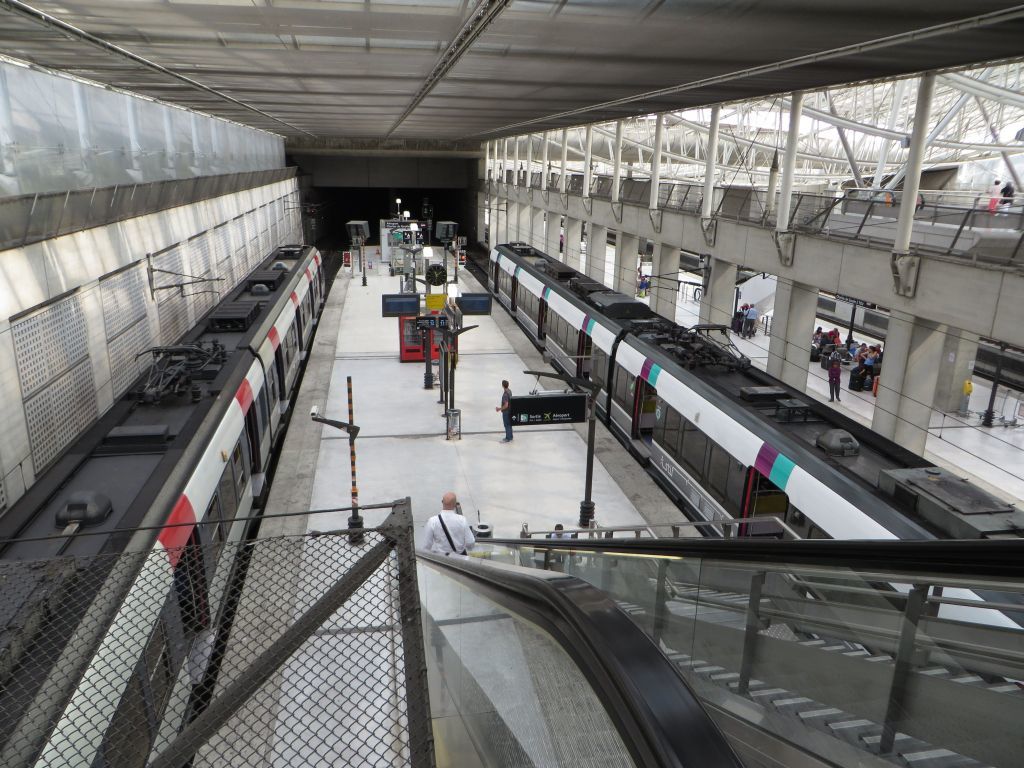
Granted, the woman who made her way through the mess of suitcases of CDG-bound passengers, standing here at the level of the doors, did not have an amplifier, which made her not so loud. But her singing was awful, really awful, and yet she received some loose change from travelers with even less musical taste than she had.
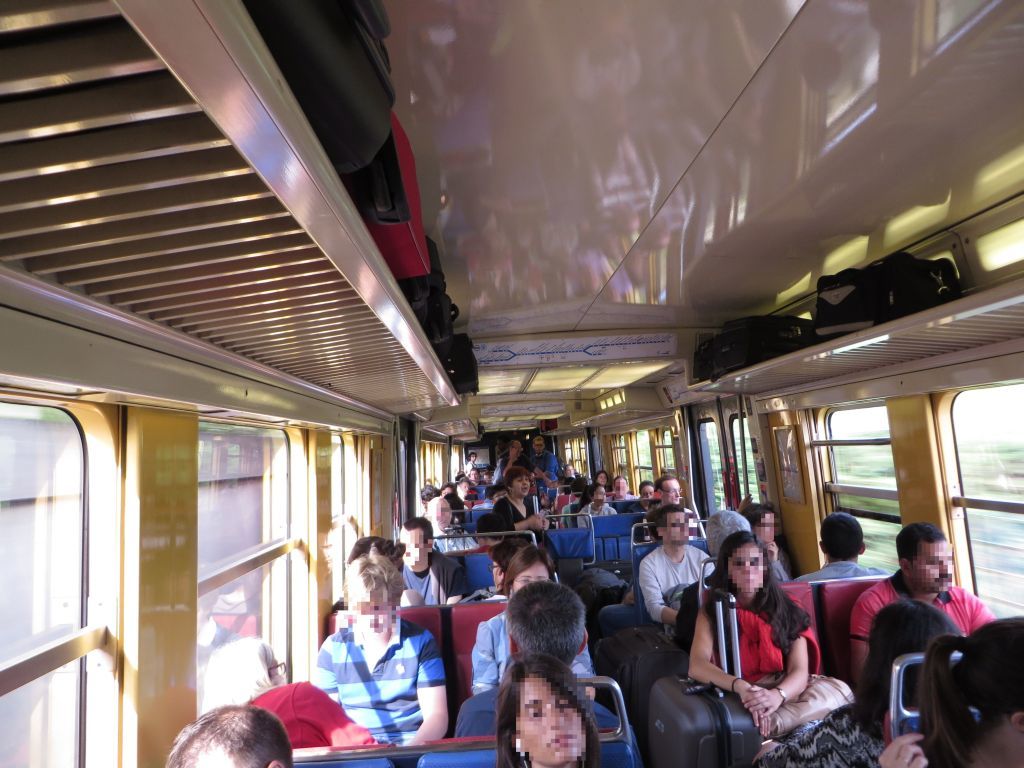
As all Paris suburb dwellers know it, the RER express train was not designed for users with bulky suitcases, and the designers of the two airport stations did not consider deviating from that. The number and the design of the exit turnstiles at CDG2 station are those of end of the lien station, period. You better be patient to go through them.

The FIDS at CDG2's mixed RER – high speed train station is known to all FR readers.

A last look at this public means of transportation, which was cheaper (although there is a surcharge on airport tickets to penalize travelers who do not waste energy), and not much slower than a taxi, due to minimal waiting at each connection.
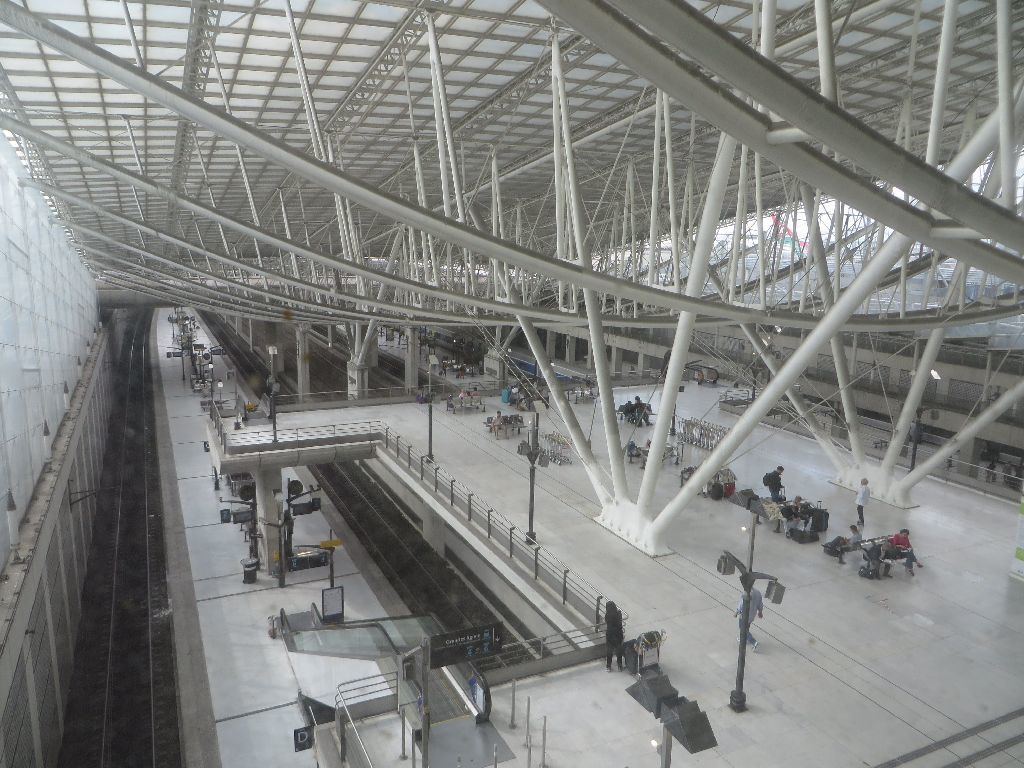
These self printing BP and luggage tag self serve printing machines suggest saving time before the travelator to Terminal 2E.
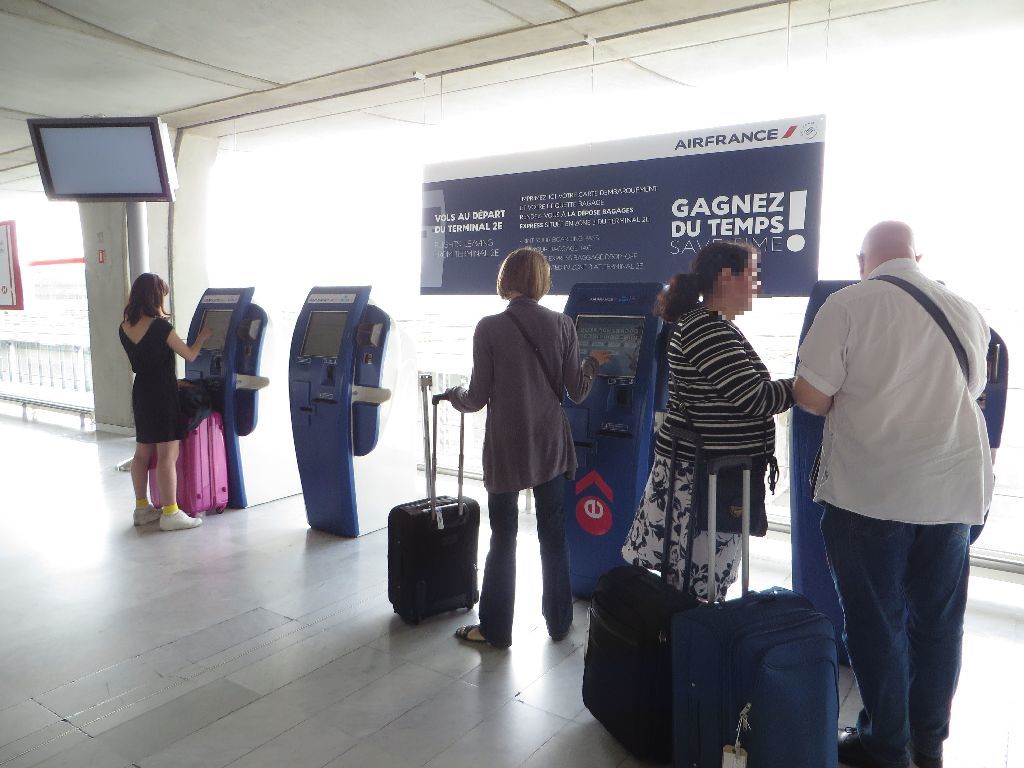
The test resulted in a waste of time: this machine stubbornly refused to leave its home page.
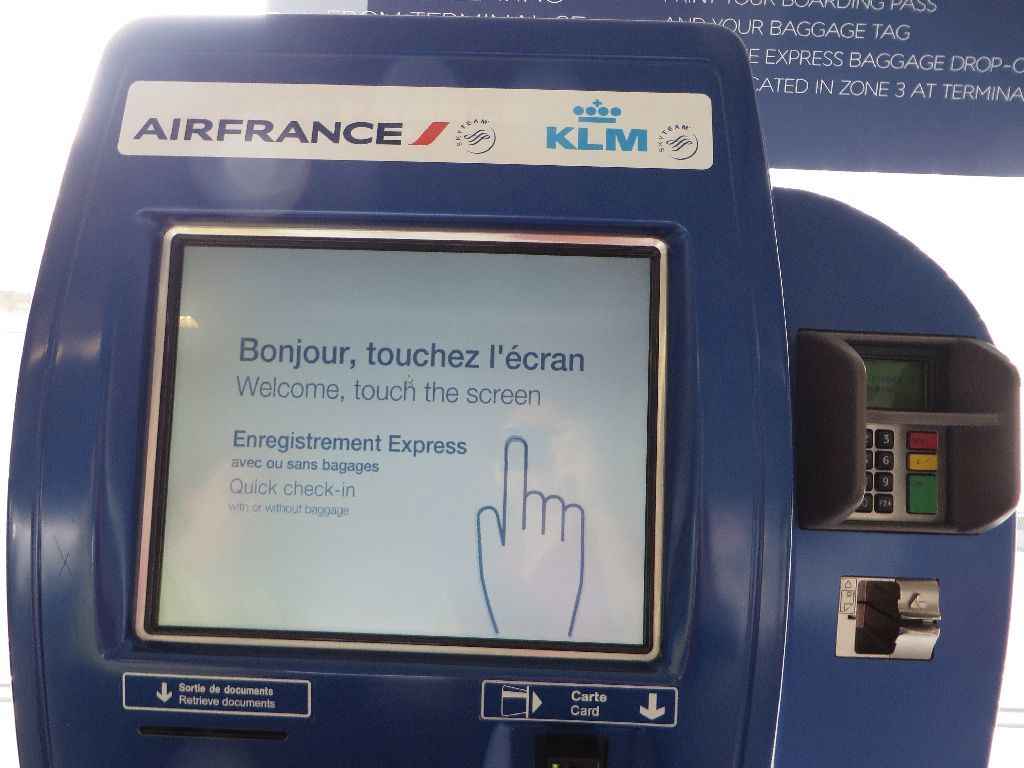
… and its neighbor adamantly refused to let me select letter T for Tokyo, no matter how I touched the screen. The most frustrating was that a Tokyo bound Japanese traveler had used it just behind I tried.
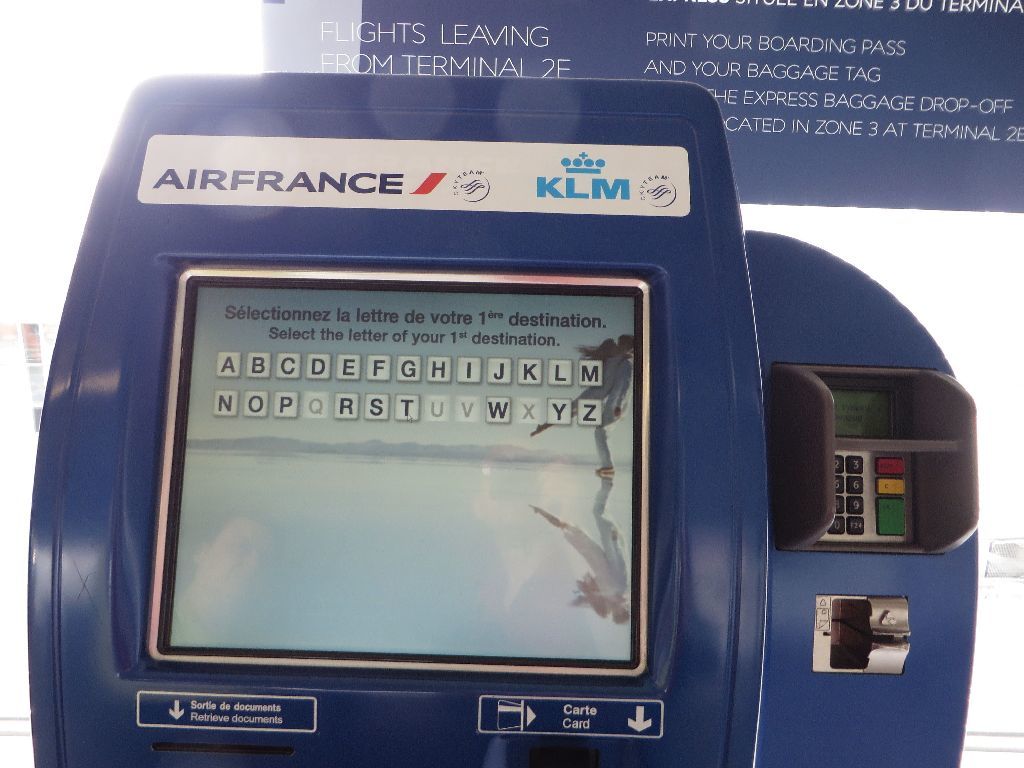
This step was a total failure, but we spent only two minutes trying.
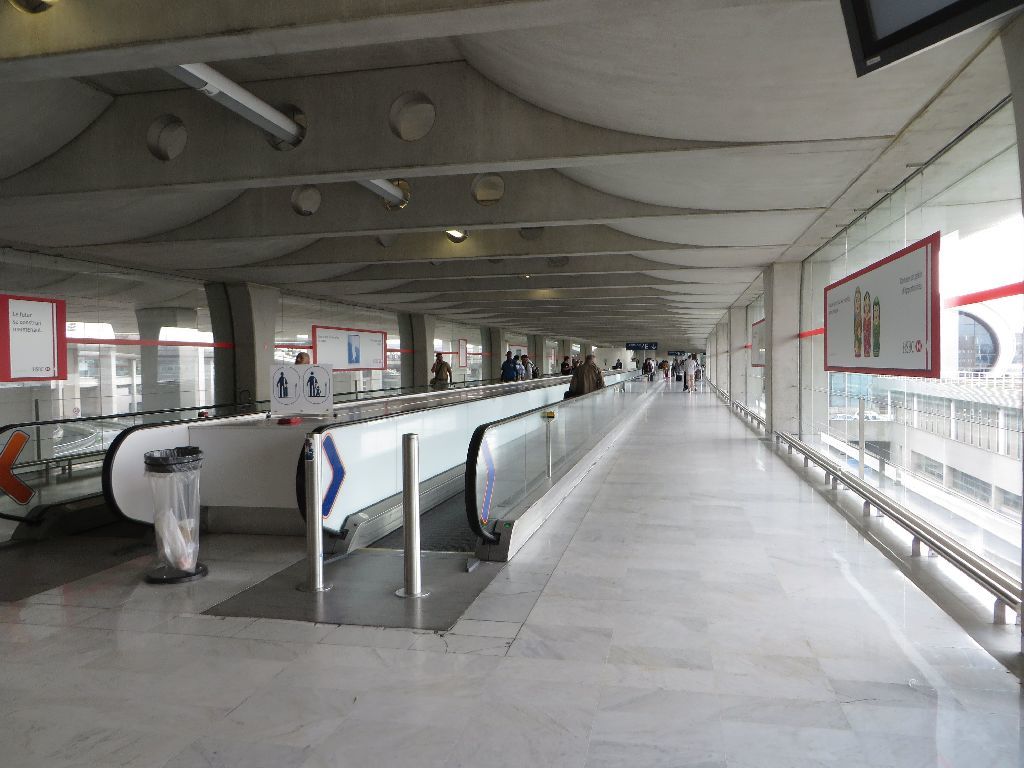
Mrs Marathon has been downgraded to FB Silver status, and I to FB Ivory, and this Sky Priority check in area is no longer for us: you have to be traveling J (or possibly Y+), or FB Elite+. Bad luck: checking in for the flight to NRT is in zone 13, at the far end of the terminal which is crowded with passengers and bulky luggage. I would not call it jammed though.
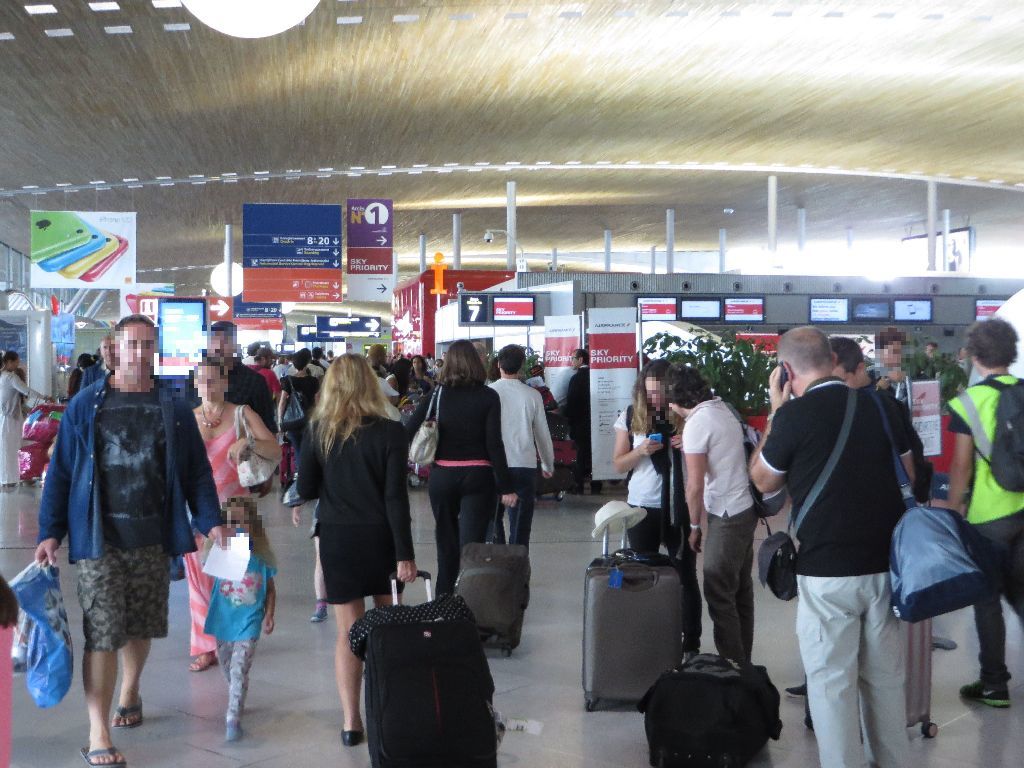
Once in Zone 13, we find the same machines which are slightly more cooperative, but slightly only, because the one I use eventually tells me that a member of my group cannot be checked in. My group consists of my wife and I, and it is unclear who AF wants to leave on the tarmac. A staff with a red shirt is already there, and I voluntarily play the role of the rookie traveler to let him manage that machine. The machine will go through an incredible number of menus, with all sorts of options which could be charged (seats, meals, extra luggage,… ), but eventually refused to print our luggage tags because a member of my group cannot be checked in, even though I had checked both of us on line the day before, and printed the BPs. We wasted six minutes at this step, before the staff gave in and directed us to the good old fashioned manual check-in counters.
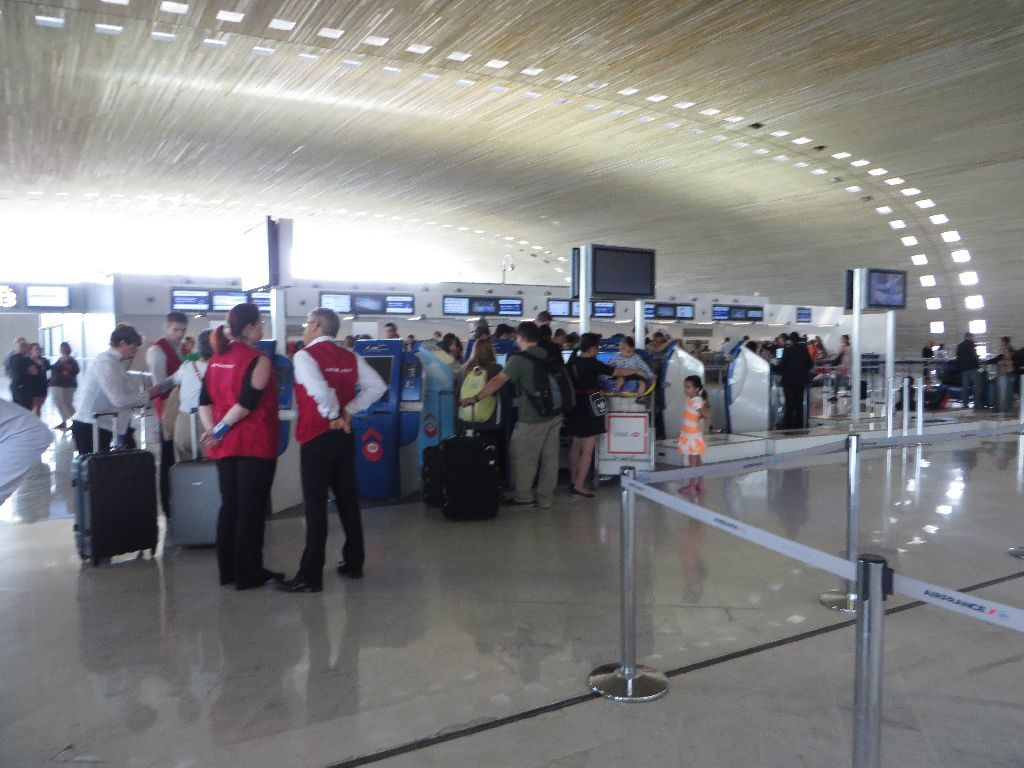
Mrs Marathon spotted this sign which was meant for her…
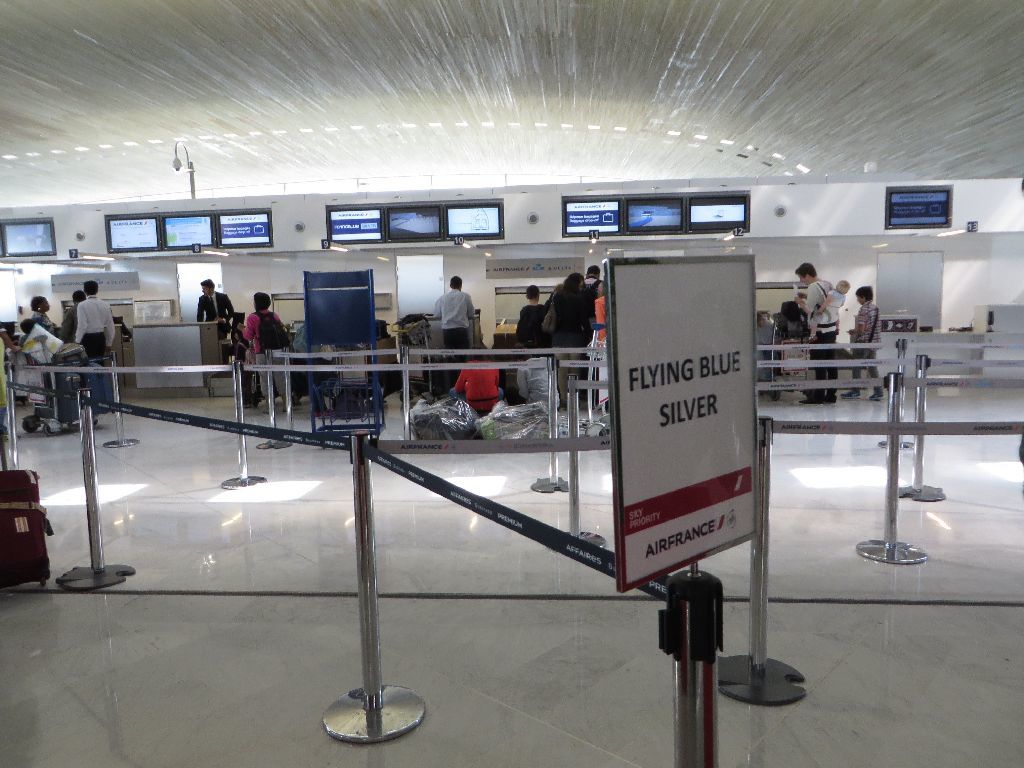
Mrs Marathon is still slightly Elite and that gave us access to the counters on the right
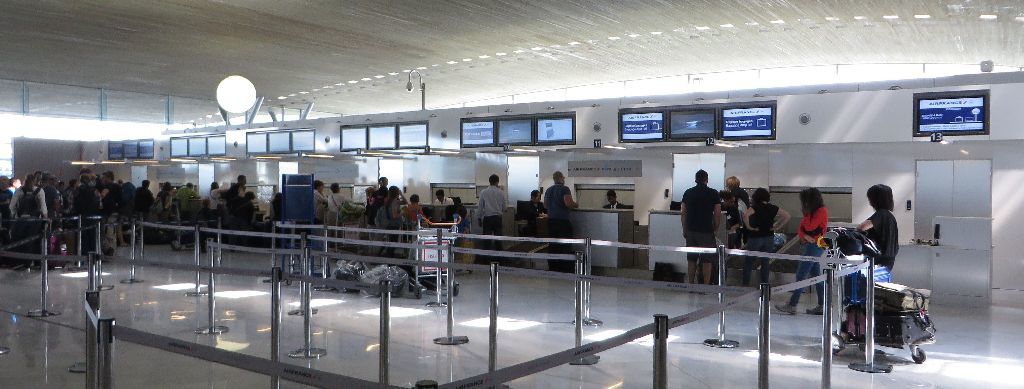
… which saved us the line on the left

A long trip, commented with a connoisseur's smile the supervisor of the staff at the desk, when she saw our routing. That the staff was obviously in training was good news, because her supervisors guided him at each step, and this long trip took long to check in: ten minutes (including two or three minutes wait for a free position). The luggage is checked to the final destination, but the next BPs will be obtained in NRT.
Your luggage is checked to JOG, confirms the staff, and we only need to see the luggage tags to know it. The staff is poorly informed, for no matter that they have tags to JOG, our luggage will wait for us in DPS. You will have to wait until the next FR to get the details.
We went through Parafe – the passport and fingerprint reading automated gates – whose access seem to be in the priority immigration lanes, but branch out a little further away. Mrs Marathon went through very quickly… and I waited for ages for the machine to think about my fingerprint being mine or not. That day, I really had lost my sense of touch with computers.
No hand luggage created any problem at the security check, but I was randomly selected for a manual frisk. That is what the agent told me. He was thorough, but warmly friendly, like I wish all his colleagues were anywhere in the world. I thanked him for his attitude.
Overall, we had reached CDG-2 train station at 11am sharp, and it was 11:56 when I took this picture airside, just after the security check. Nearly an hour elapsed, even though Mrs Marathon FB-Silver status saved us around a quarter of an hour of waiting for checking in our luggage. A dismal performance for CDG.

There was no luggage cart in the areas like this one where there should have been…

… but after a search of the area airside, I found several abandoned behind a shop (I did not need any, actually, but was wondering where they had vanished).
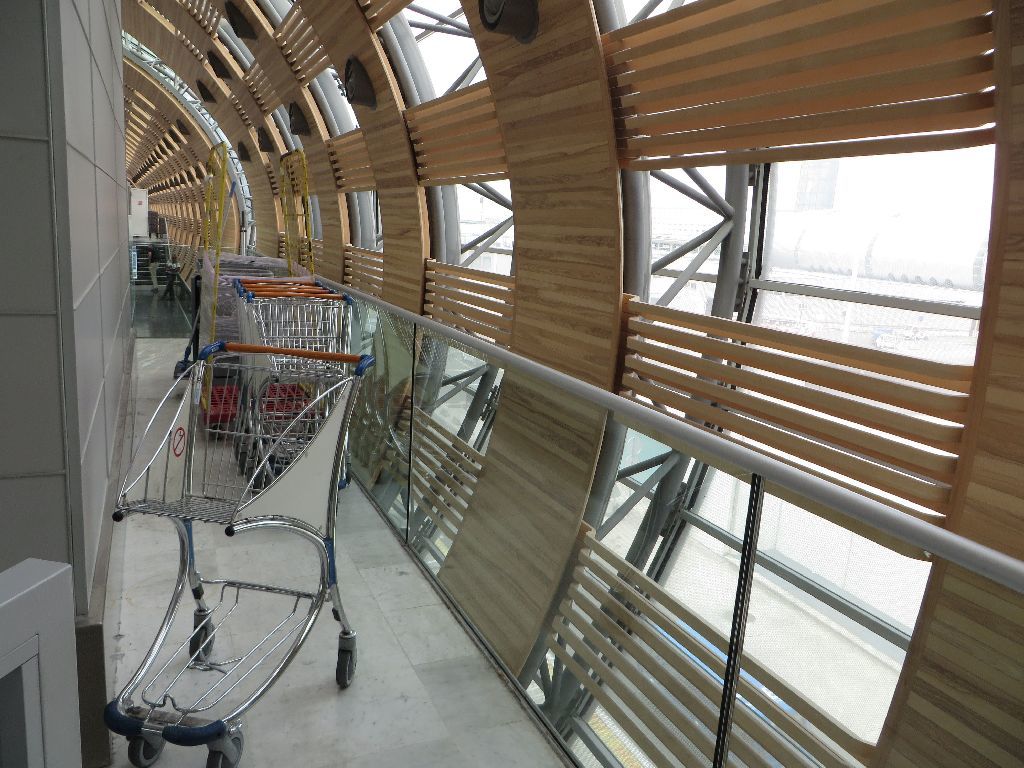
Our flight boards at K43, and by this time, the plane is already there.

It is a 77W in Skyteam livery which (unfortunately) does not mean that the interior is any different from the other 77W in AF's fleet. A thin crisscross pattern on the windows creates a fog effect and is part of CDG's plane spotter unfriendliness. Too bad that AF's maintenance unit does not have a spare nose cover of the correct color: this one in standard AF white does not match the silver grey livery.
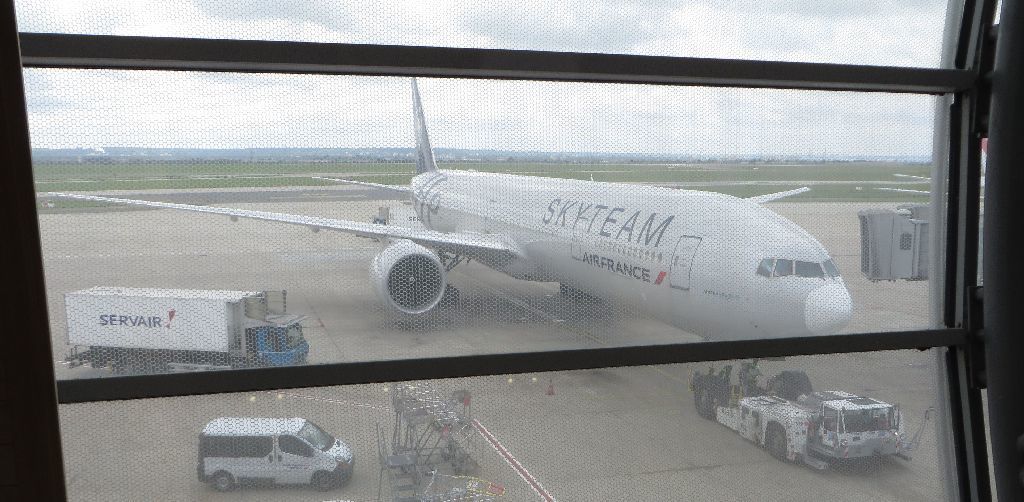
There are not many of them, and they are somewhat hidden, but there are type E power ports. We moved to different seats, not because of the waste bin's proximity, but because of a cold air draft here…
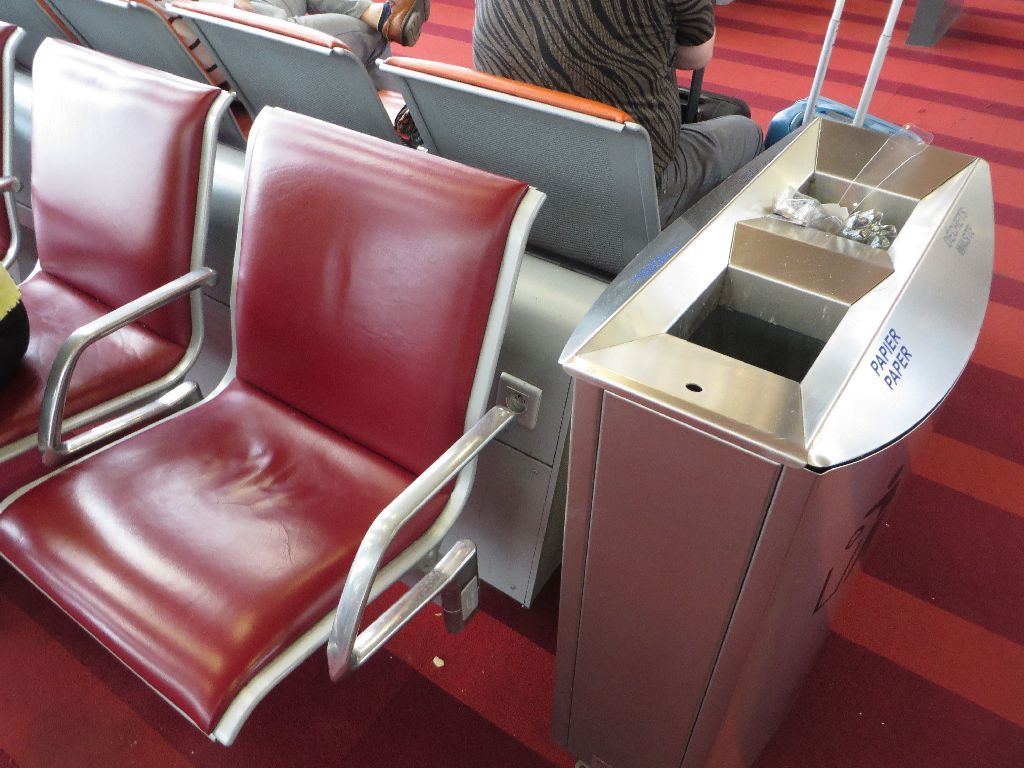
… where there is no dustbin, and less of a cold draft.

The priority PAX (according to their handicap, age or pregnancy, not their FF status or class of travel) have individual power sockets at their seat. Fair deal.
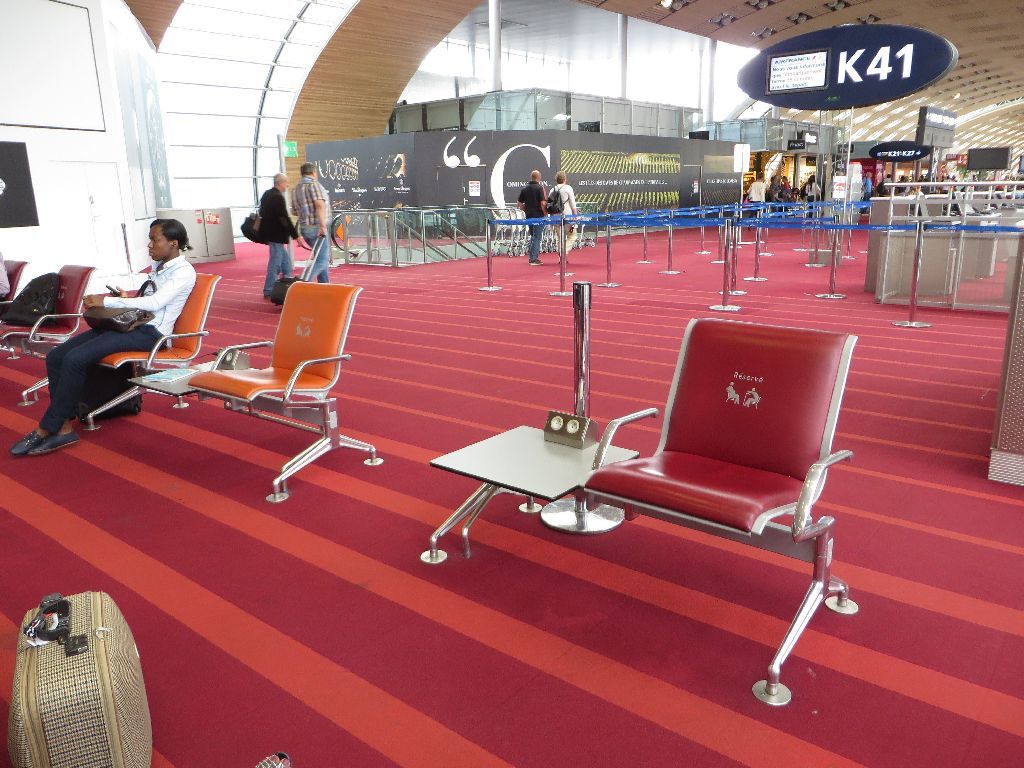
With regards to toilets which are at the lower level, there is no doubt that there are too few of them, in both male and female sections, because there was a waiting line in all the places that I checked, near the boarding gates and in the duty-free section.

And the one that I patronized were not luxurious: the hand towel had not been replaced.
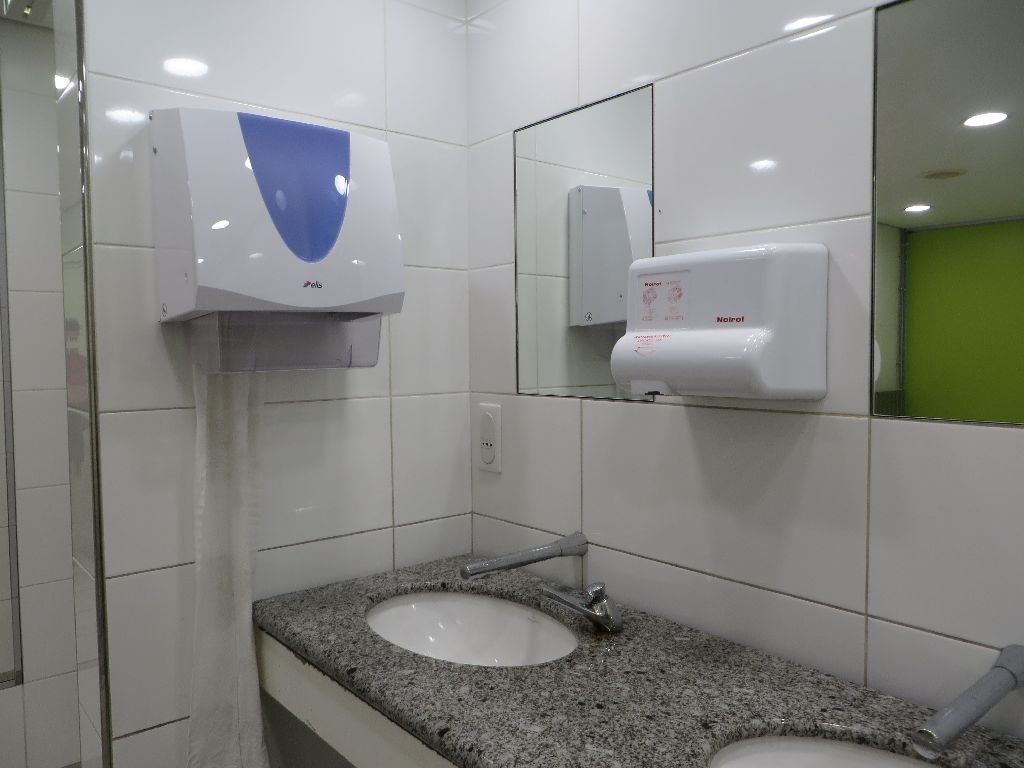
And the stall that I used was full of graffiti. I spare you the disposable toilet seat covers which had been disposed of on the ground, because there was garbage container for them.
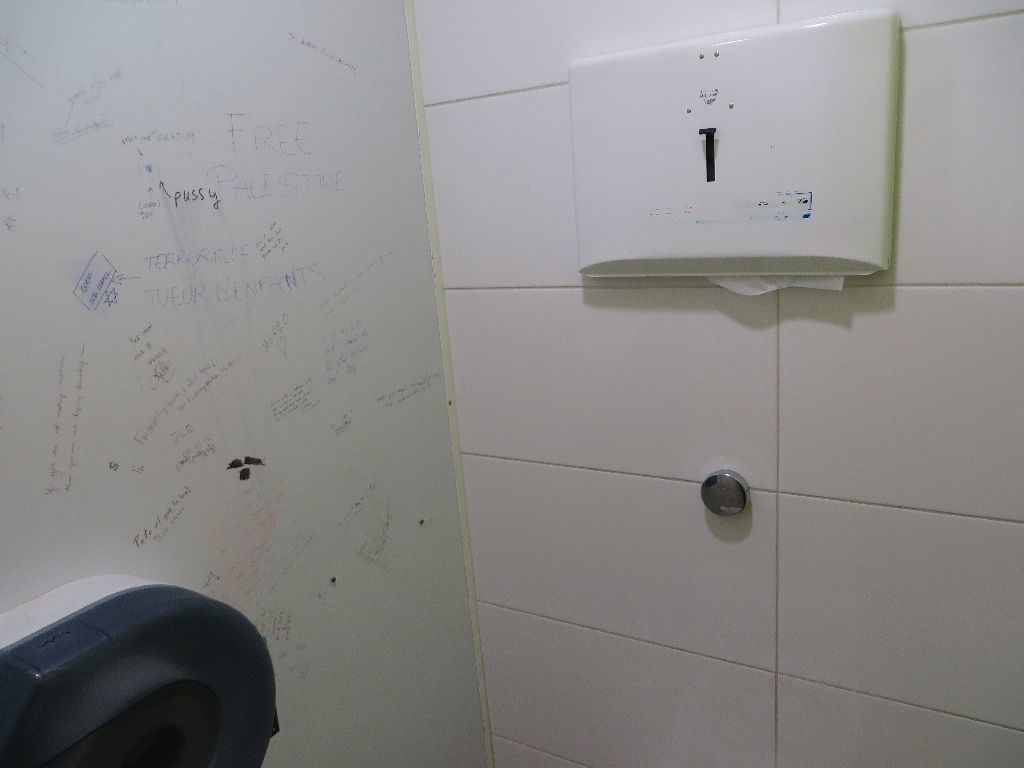
Sigh…
There is a play area beyond this food court
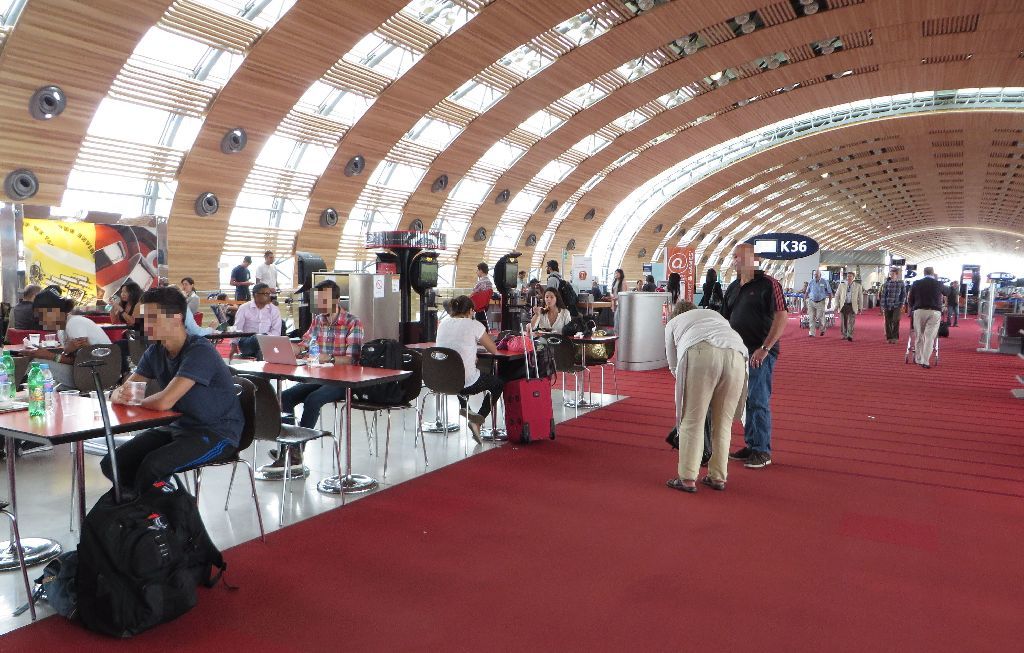
… with PS3 consoles which work. In the background, self serve computers with free internet access for 15 minutes and more for a fee. I do not know if the free access is more accessible than in NCE, because unlimited wifi internet access is at long last free in CDG and ORY.
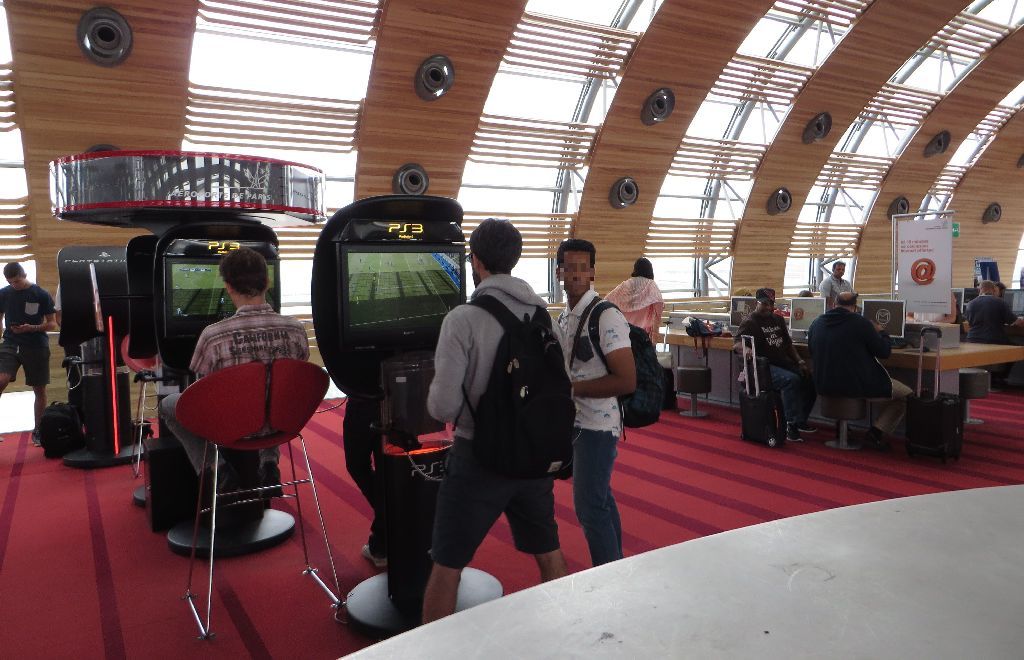
For the younger generation, there are two kids' corners, one with overt male stereotypes
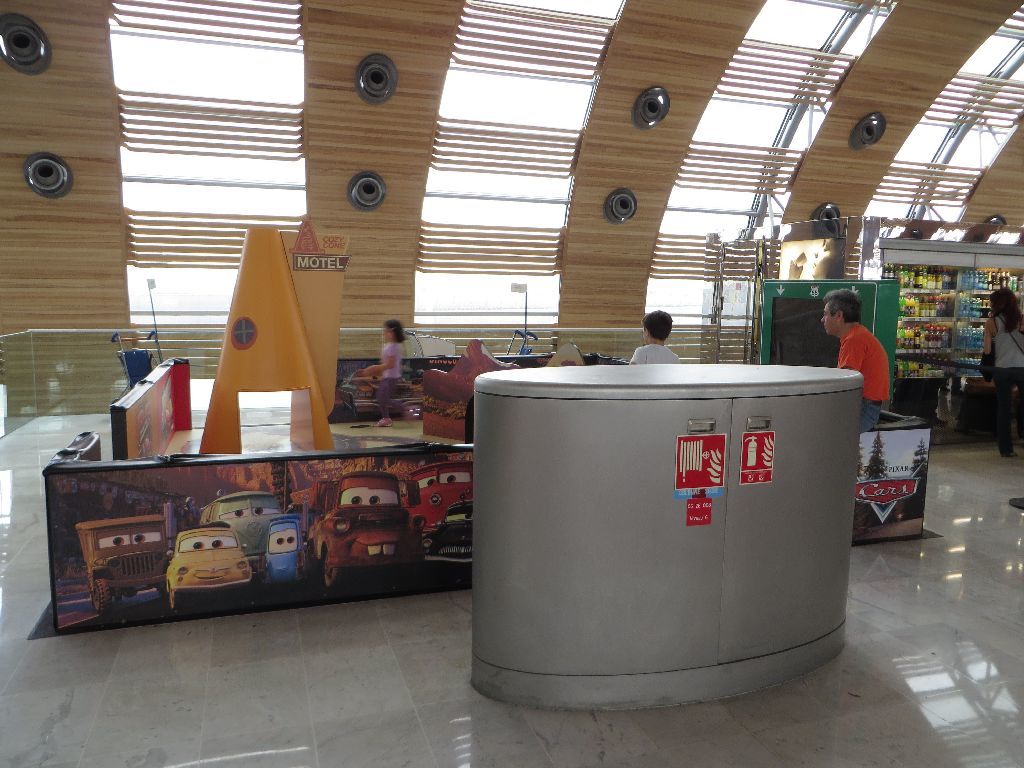
And the other one mixed, with a Cars boys' section and a Fairy tale princess cliché girls' section … but where a boy plays hides and seek with his mother.
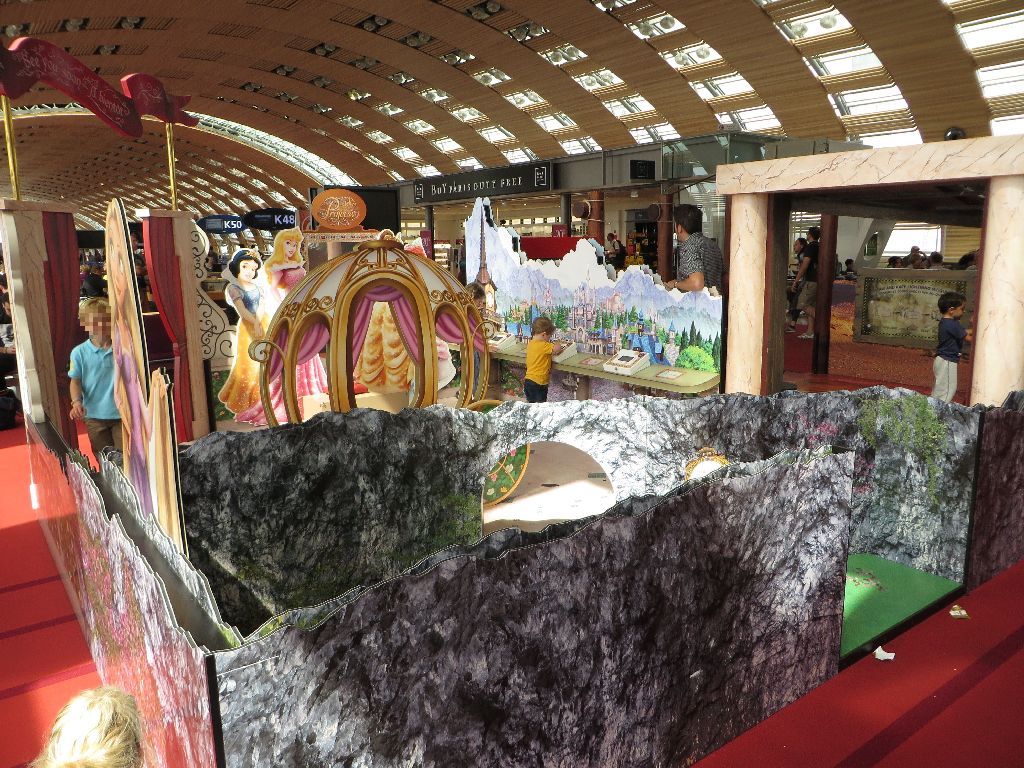
This area is not for kids of either sex: contrary to you might deduct from the stickers in the foreground, these are two smoking areas a few steps below the general level of the terminal.
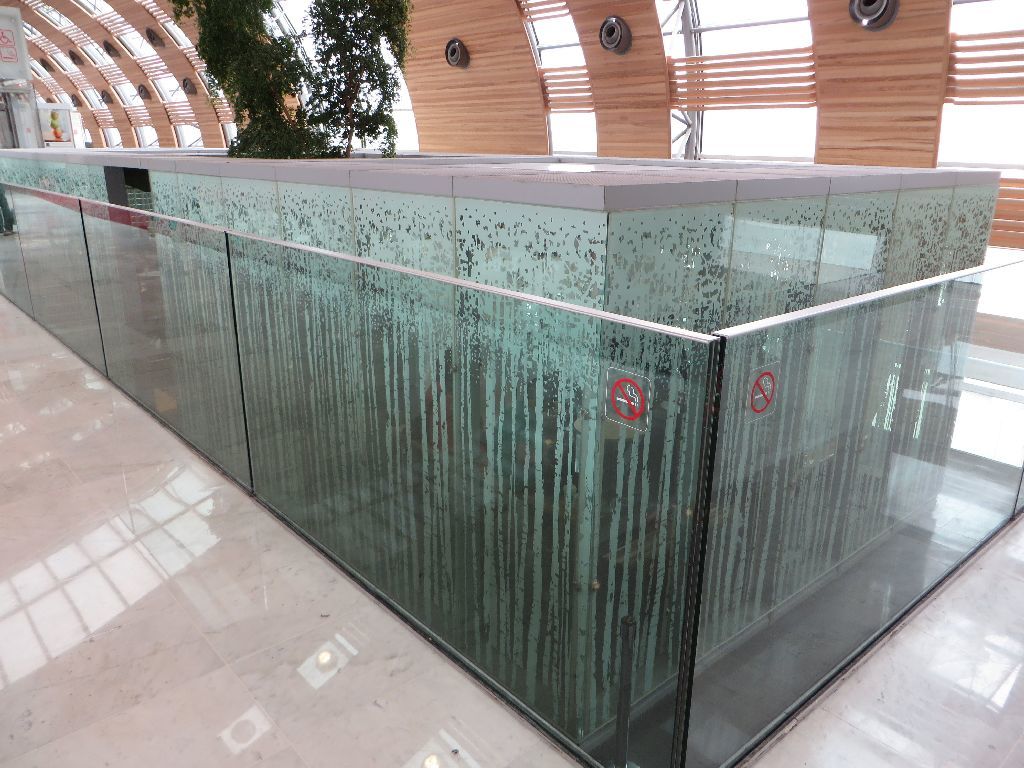
One of the ends of the terminal is reasonably plane spotter-friendly, but I did not get a chance to use it. The reason is that a passenger suddenly sprang out from his seat: another Flight Reporter who knows me well! It was a very friendly unplanned meeting.

We chatted until time was up for both of us to board (not in the same place), and I did not not event have time to take a picture of the corporate screen. This was the first time I could use the internet access since it became unlimited on July 1st, and I didn't.
Priority boarding was the second (and last, for the way in) advantage provided by Mrs Marathon's FB Silver status.
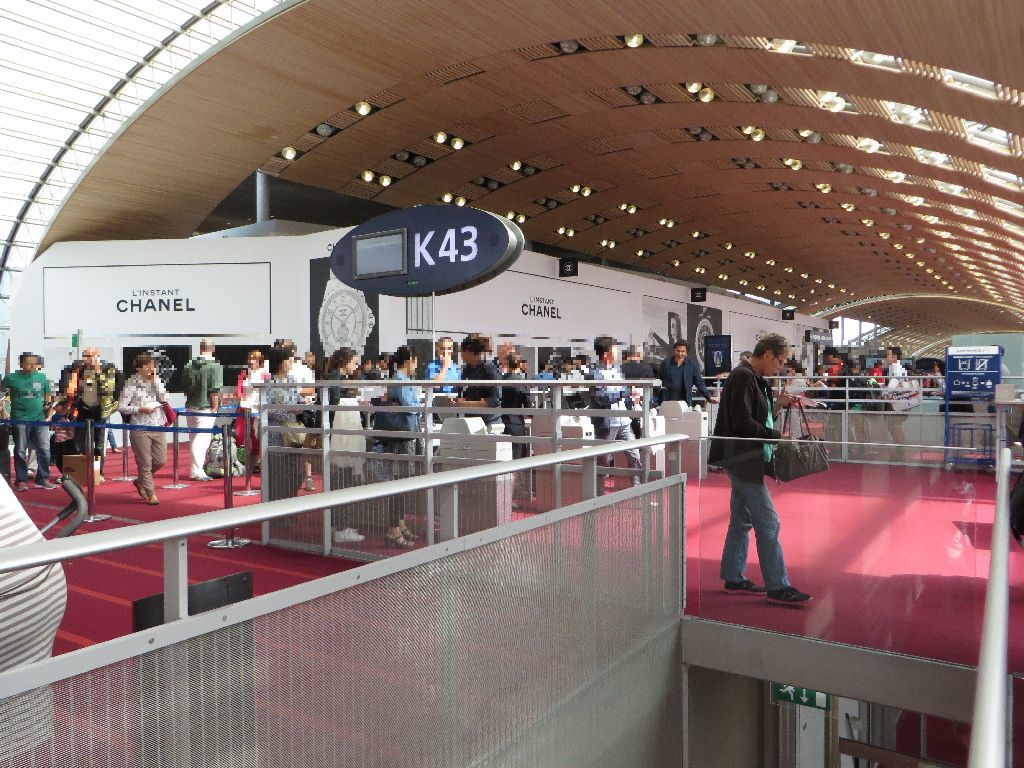
That allowed us to have a reasonably full newspaper stand, but my guess is that there would be enough French language newspapers anyway, because there was a huge majority of Japanese on board.
For the record, the F section, which was to have two, possibly three passengers, from the leftover stuff when I disembarked, out of eight seats (two rows in 1-2-1 layout).

The last rows of the J cabin, that only my camera could make believe that it features such a wide open window in the background. The layout becomes 2-3-2.
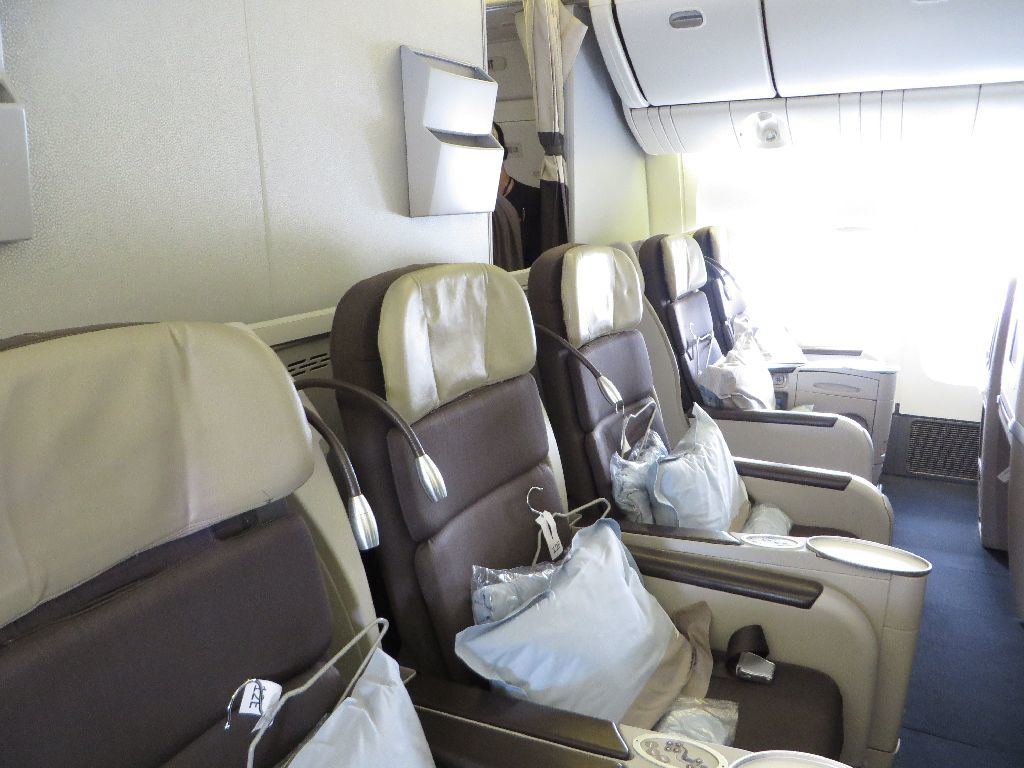
Then Y+, in a 2-4-2 layout
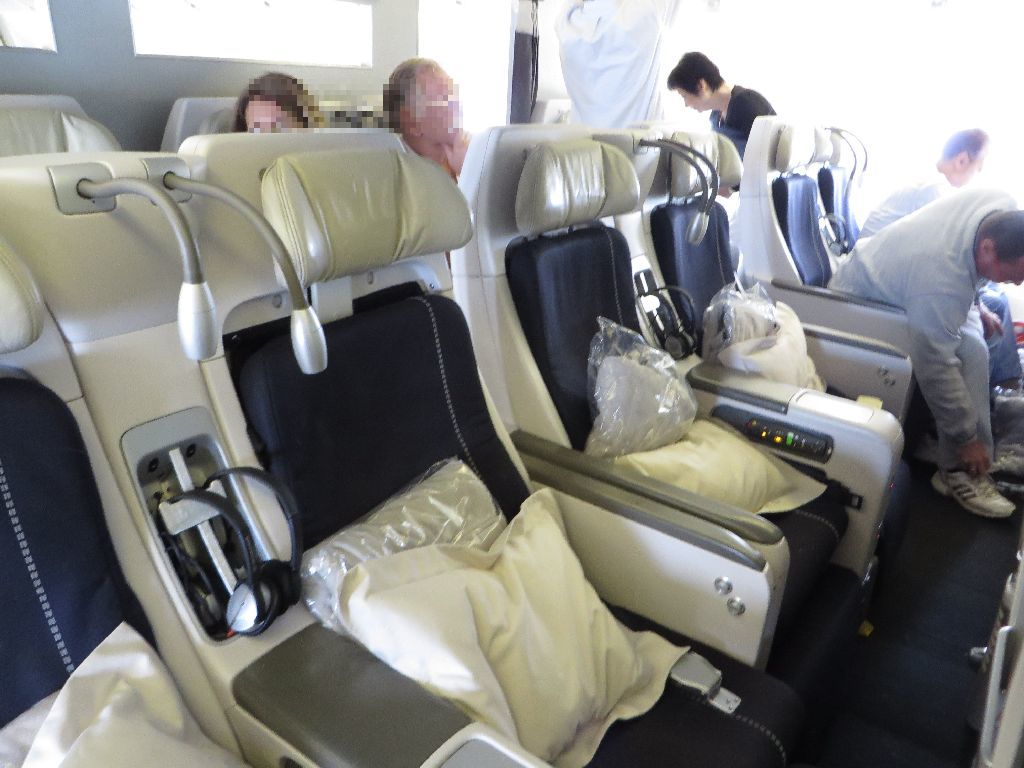
And then steerage, usually coded Y, in a 3-4-3 layout, from the front
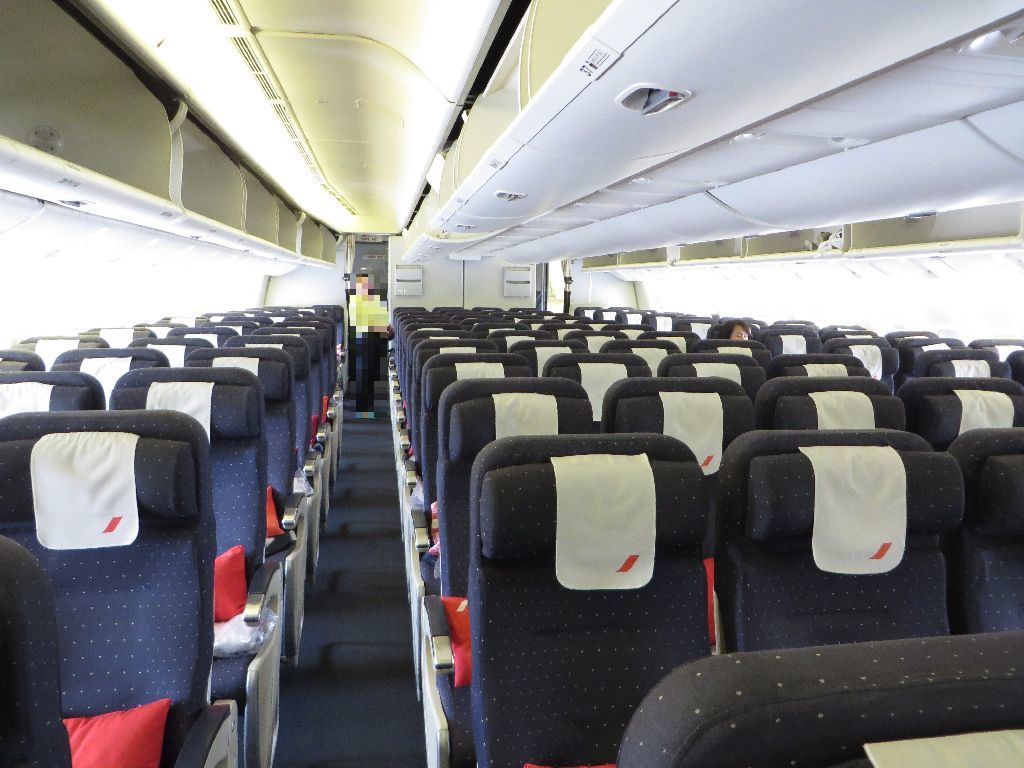
… and from the rear
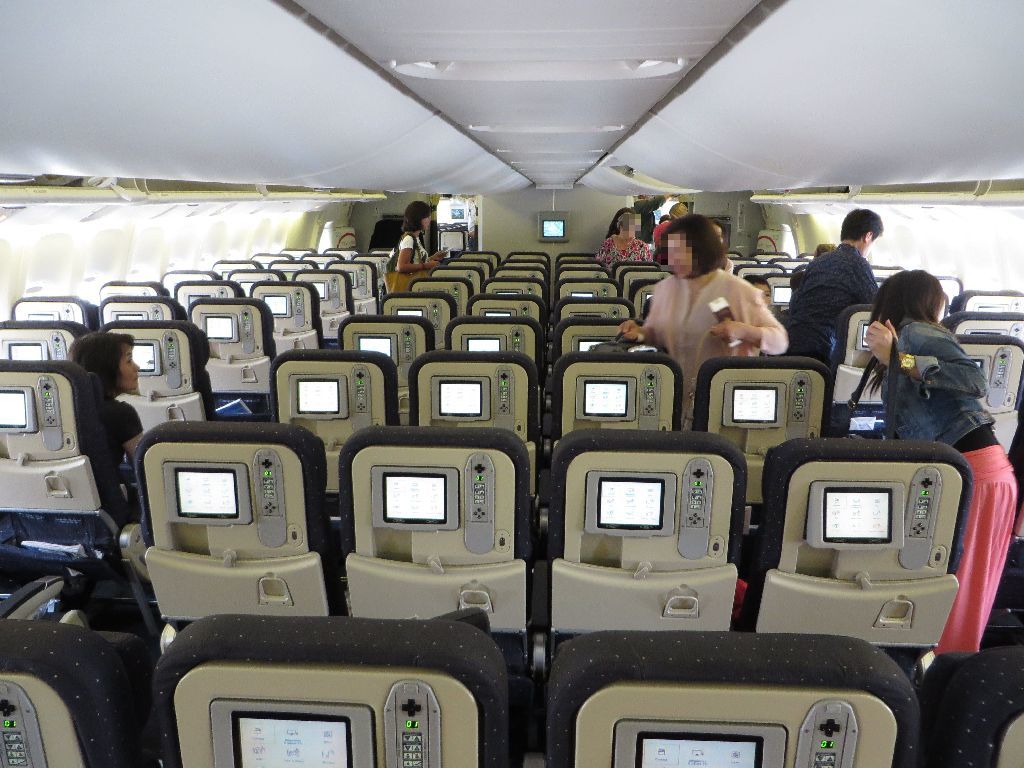
A 3-4-3 layout in a 777 is VERY tight laterally. Try and reduce the width of your favorite armchair to 43 cm between armrests, using books or whatever rigid items, and you will understand well before you spent ten hours there.
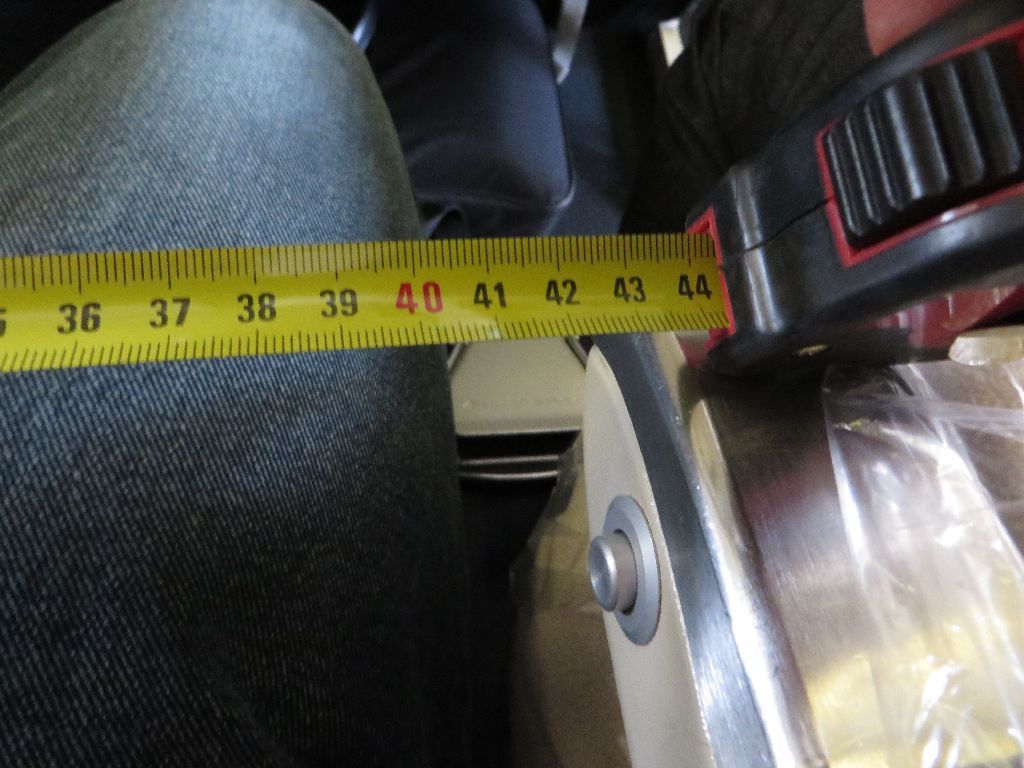
Not only are the seats narrow, the aisle are narrow too. It is no chance if I chose seats in the rear, where the layout becomes 2-4-2 because of the narrowing of the plane's body. You are among the last to leave the plane, but you are not bumped into during the entire flights by passengers going up and down the aisle during the flight. True enough, that risk is lessened when the flight is full of Japanese who care for fellow travelers. I could not keep a grunge against my Japanese neighbor who took position of our common arm rest: the spam is always tight in the can.
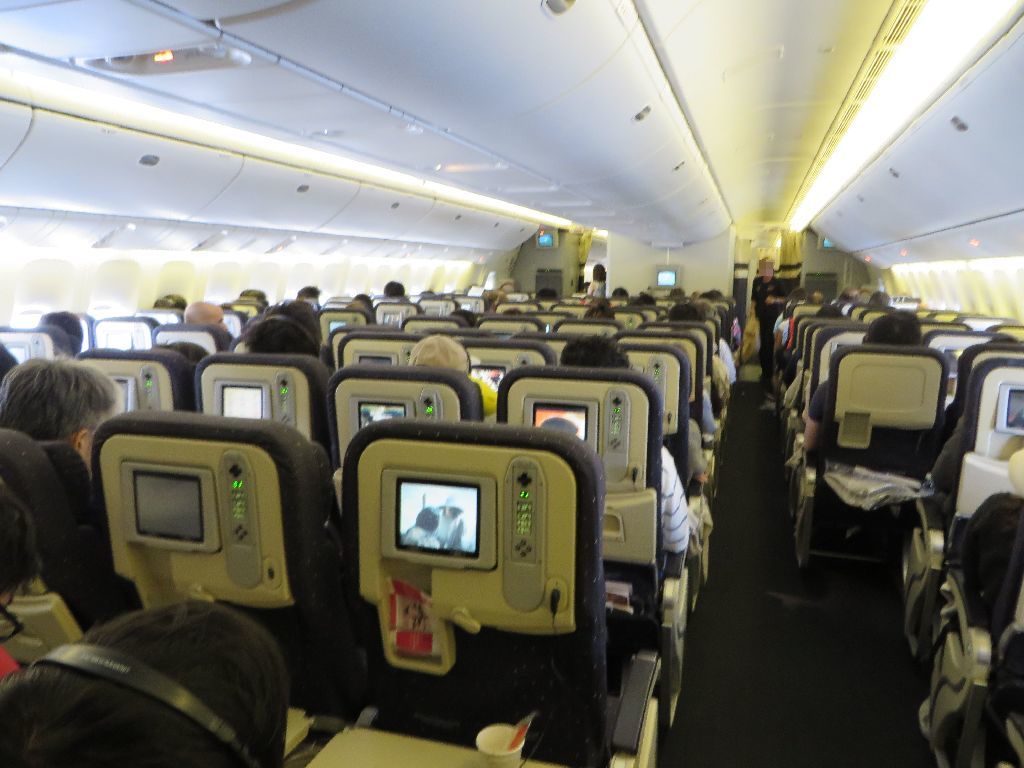
There was a cushion on the seat that I did not use, with a negative logo (white off a red background).
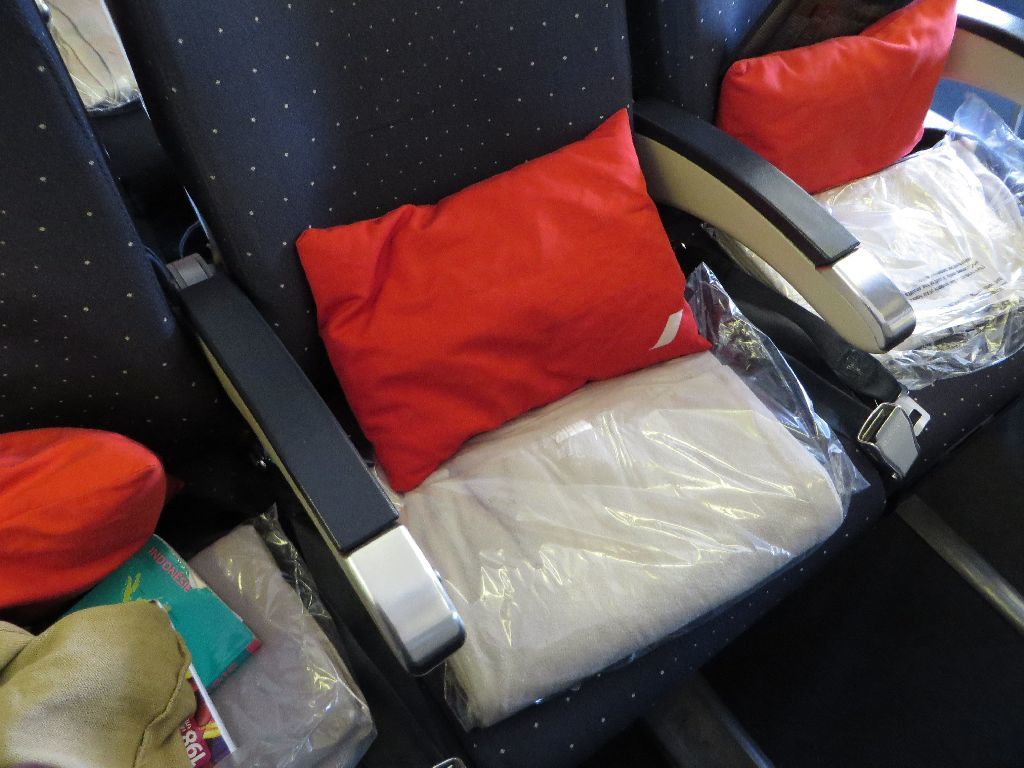
The blanket was a rather thin fleece, pleasantly soft and decently sized (I forgot to measure). It was going to be useful, because there was a super cold draft from the ceiling, which from my experience was a failsafe recipe to catch a cold. A simple cap like that of the passenger in front of me would not be enough…
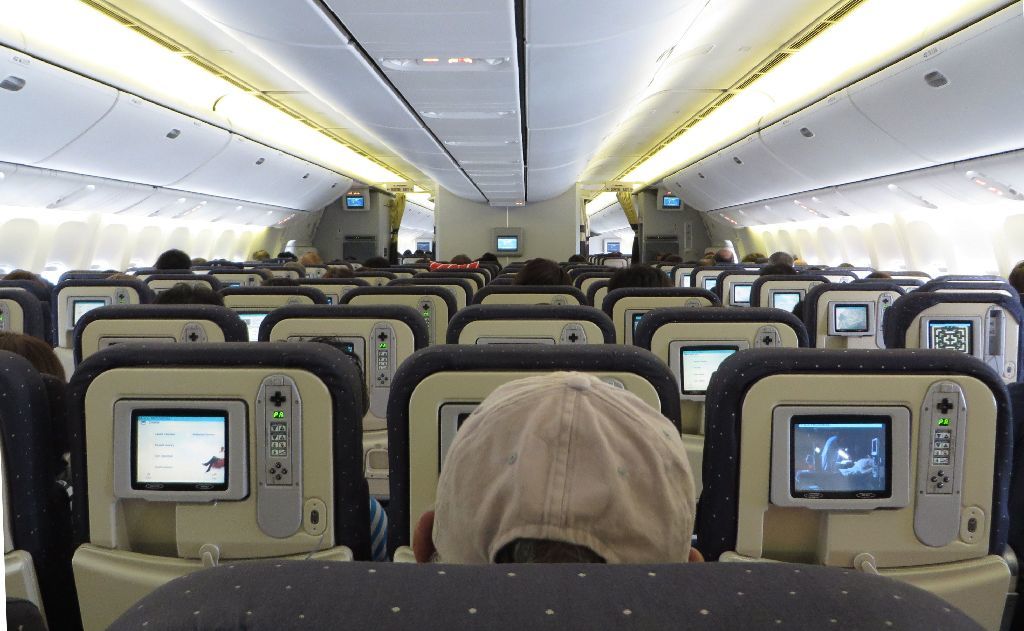

… and I used an efficient method that I had already used in J on a CX flight:

You look like a nun, my wife told me after taking this picture. Later, when I decided to get some sleep, I changed religion by covering entirely the head and shoulders with that blanket, yielding a fetching Afghan burqa look. I do not have a picture for that and let you imagine. The medical preventive target was met, which nullified any criticisms on grounds of aesthetics.
Let's go back to the seat: it is not only too narrow (and also quite hard), but the supporting legs are poorly located. The space below a row of four seats is actually divided in three, which makes it inconvenient to place hand luggage underneath. Travelling with a majority of Japanese on board is once again an advantage, because they always travel light, in particular with regards to their hand luggage. This is the 宅急便 takkyūbin culture, from the name of this express point to point delivery service which is everywhere in Japan: why bother with a bulky suitcase during the trip when it can be sent beforehand ?
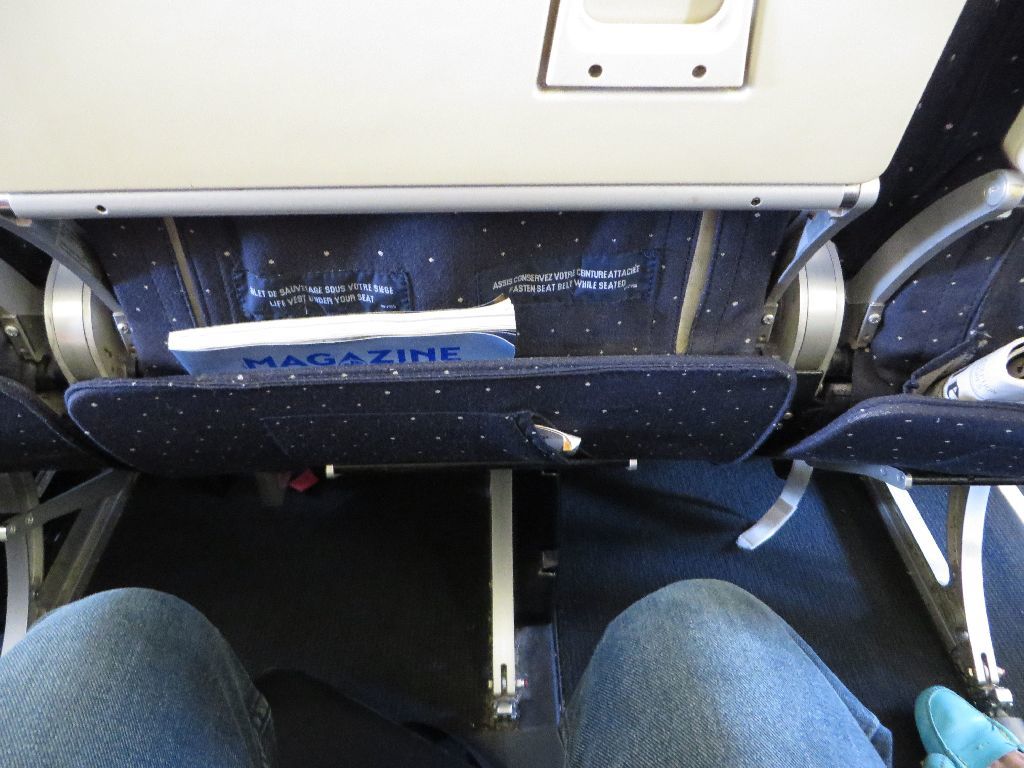
The seat has side supports for the head…
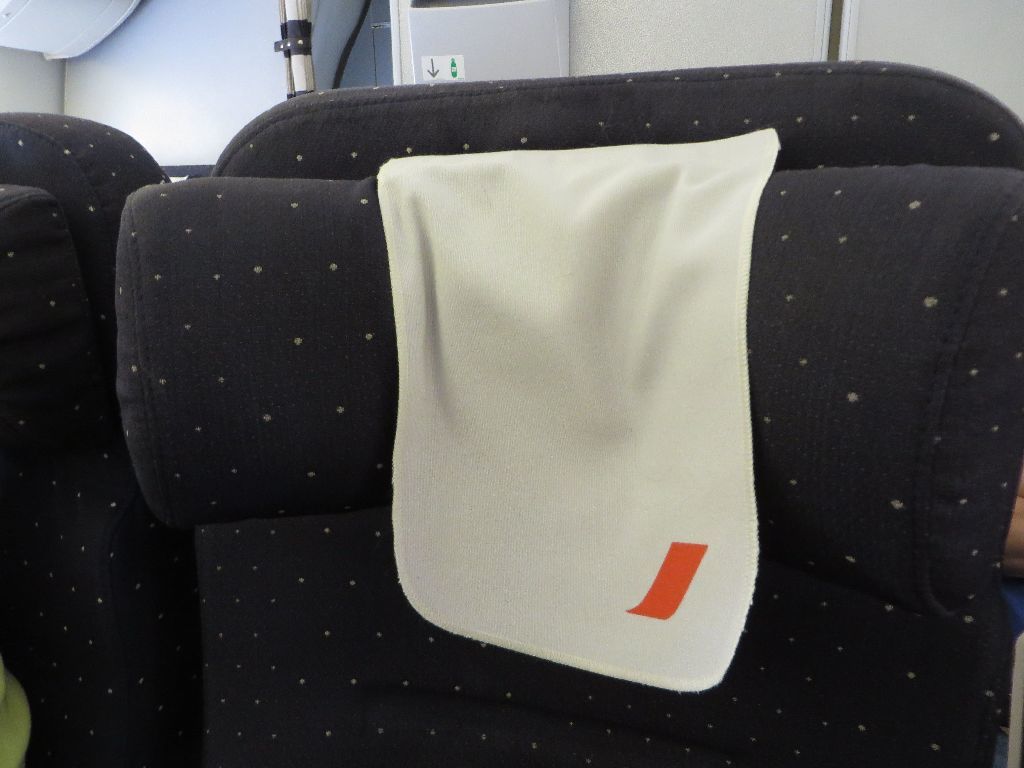
… but they do not hold in place, which makes an inflatable neck cushion valuable. We had our own, similar to that of that Japanese traveler. Too bad the seat was not designed correctly – it seemed like a cheap make-believe contraption.
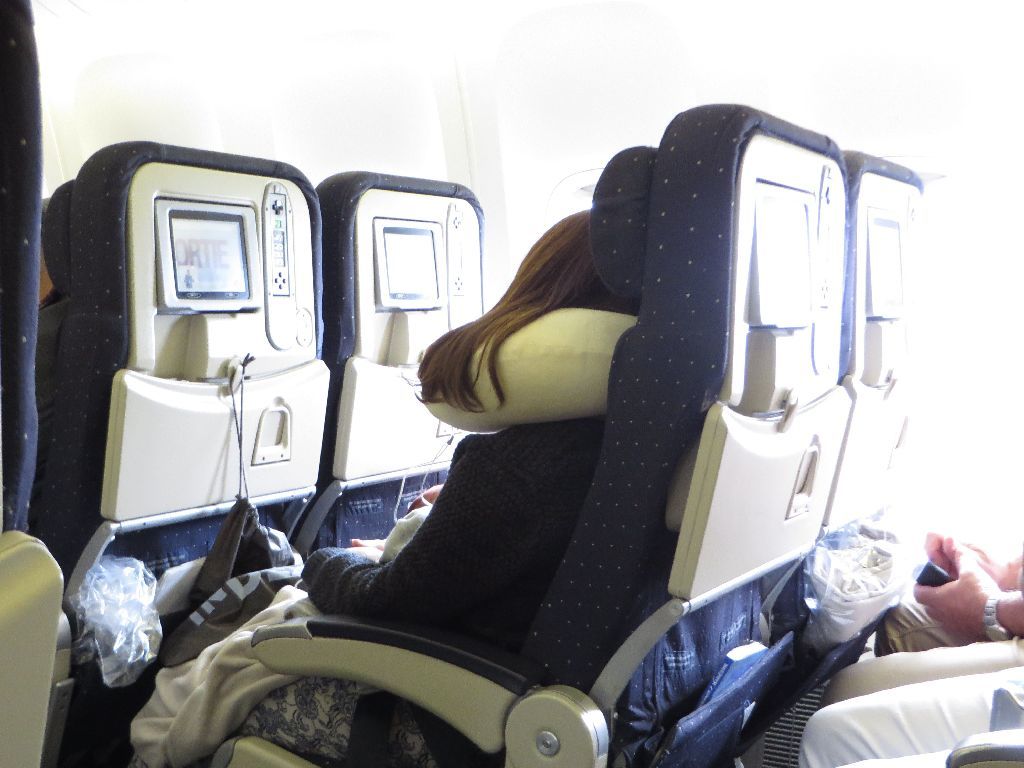
Apart from that, we have an IFE whose main problem is not its small size, but its poor image resolution.

It made it difficult to play Shanghai (my favorite IFE game), because I had a hard time telling the respective height of the piles of tiles. The mouse control was imprecise, too.
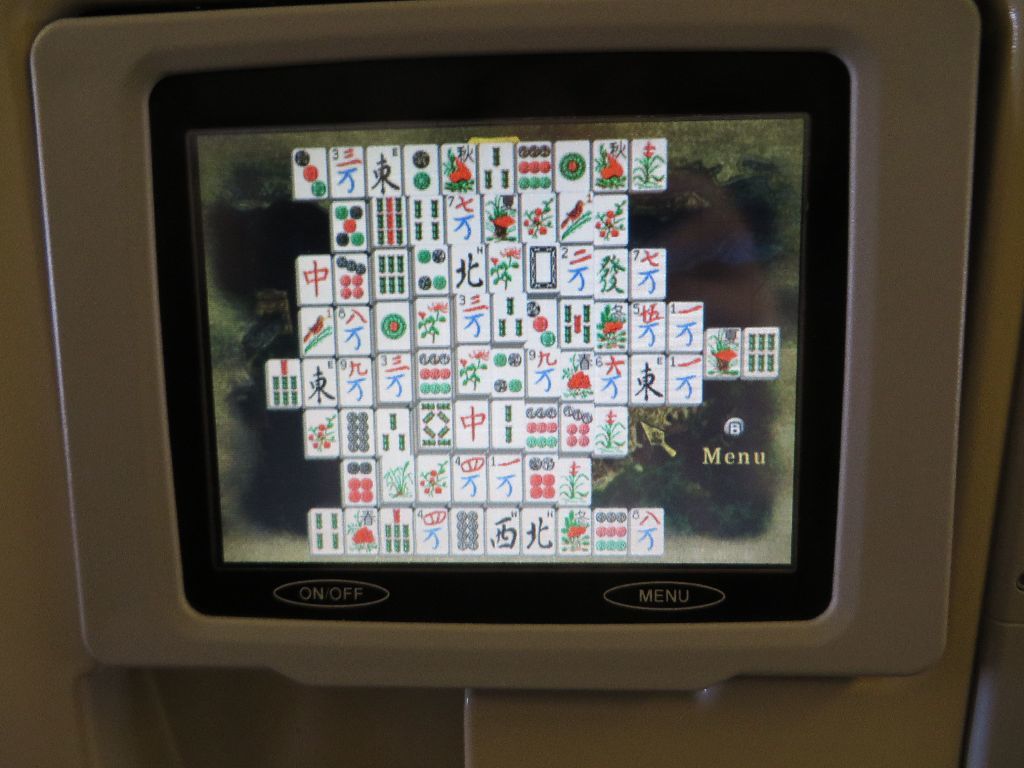
The audio and video offering is not very rich, but we enjoyed a standard 26 minute long documentary on Cologne's cathedral. It was more oriented towards the architecture than the bonus in my recent CGN-IST report, and was interesting even though it did not bring me eye-opening information.

On the other hand, forget about Euronews.
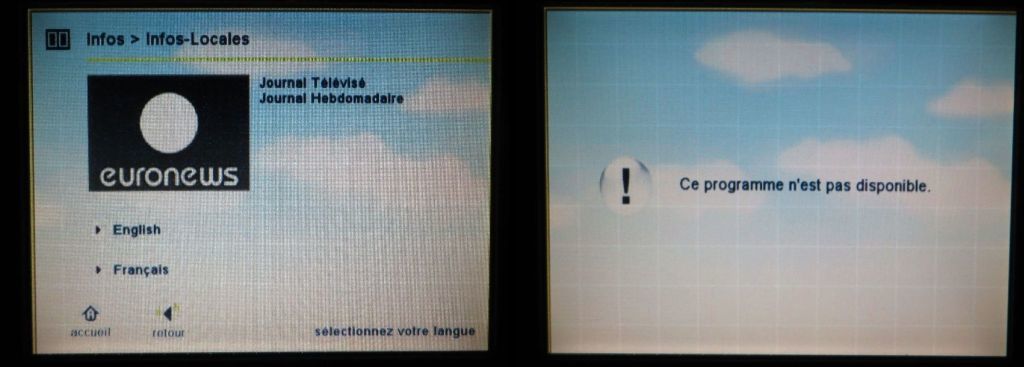
On the audio side, a rather eclectic selection of pieces sung by Accentus (one of the very few professional choirs in Paris, conducted by Laurence Equilbey) was evidently pleasant listening…
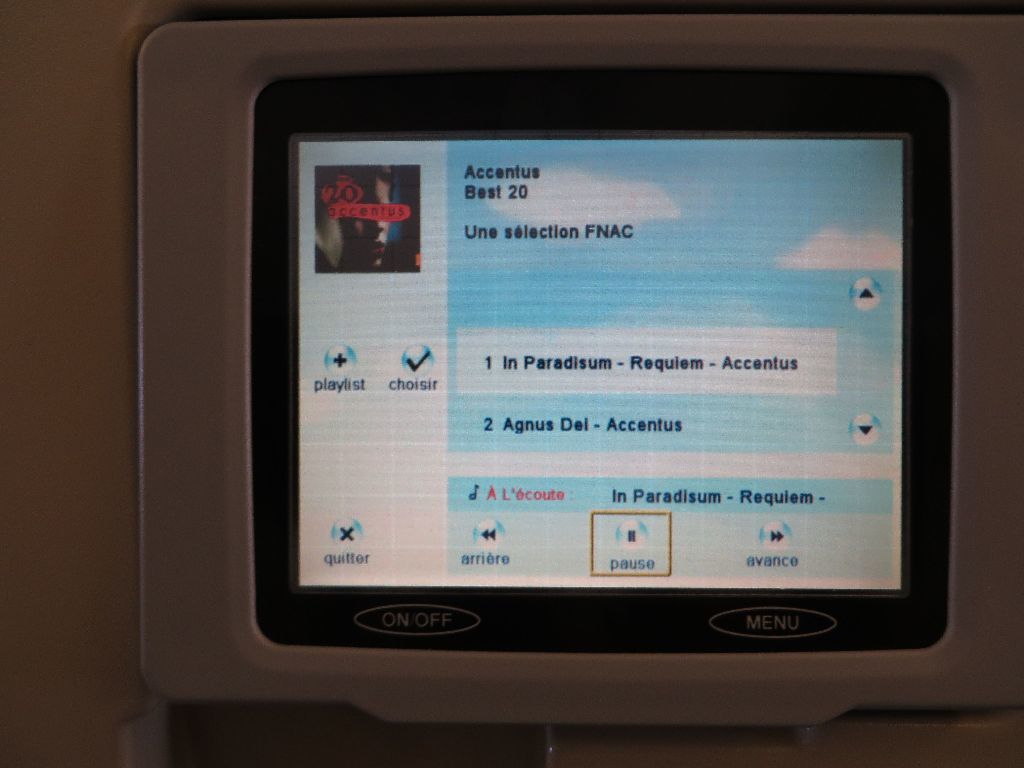
… if you tolerate the limitations of these very cheap headphones..
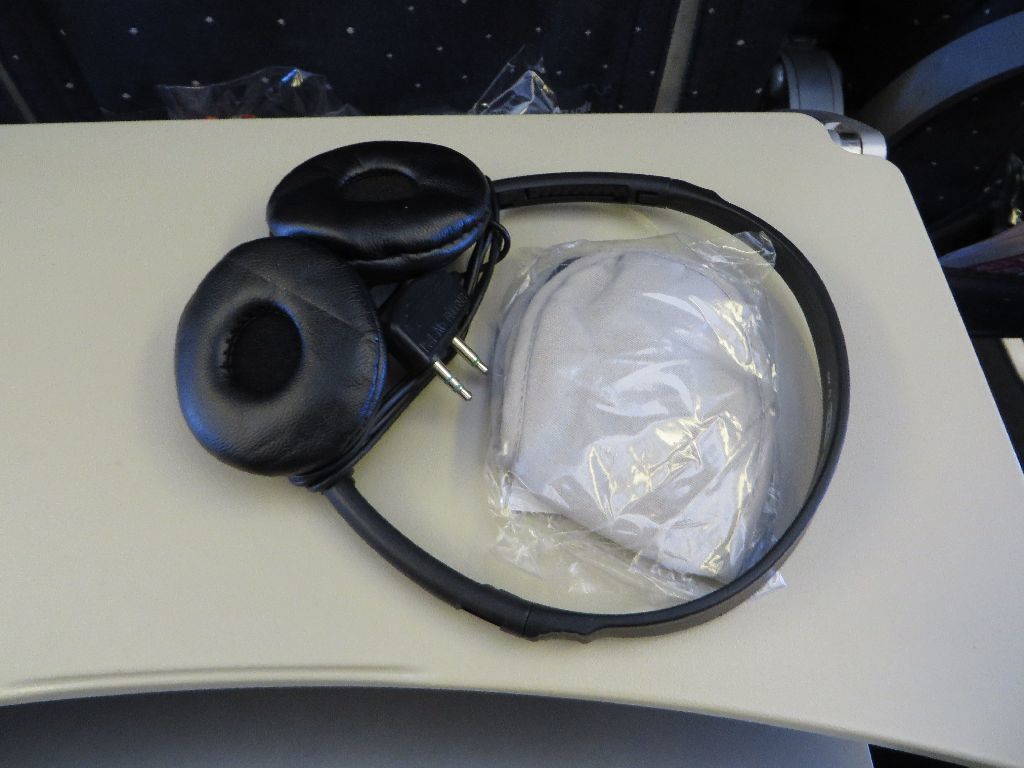
… from an audio or a mechanical point of view : this is what happens if you forget about unplugging that of your wife when moving to the toilet: the plug is the weak link. It was still useable, though.
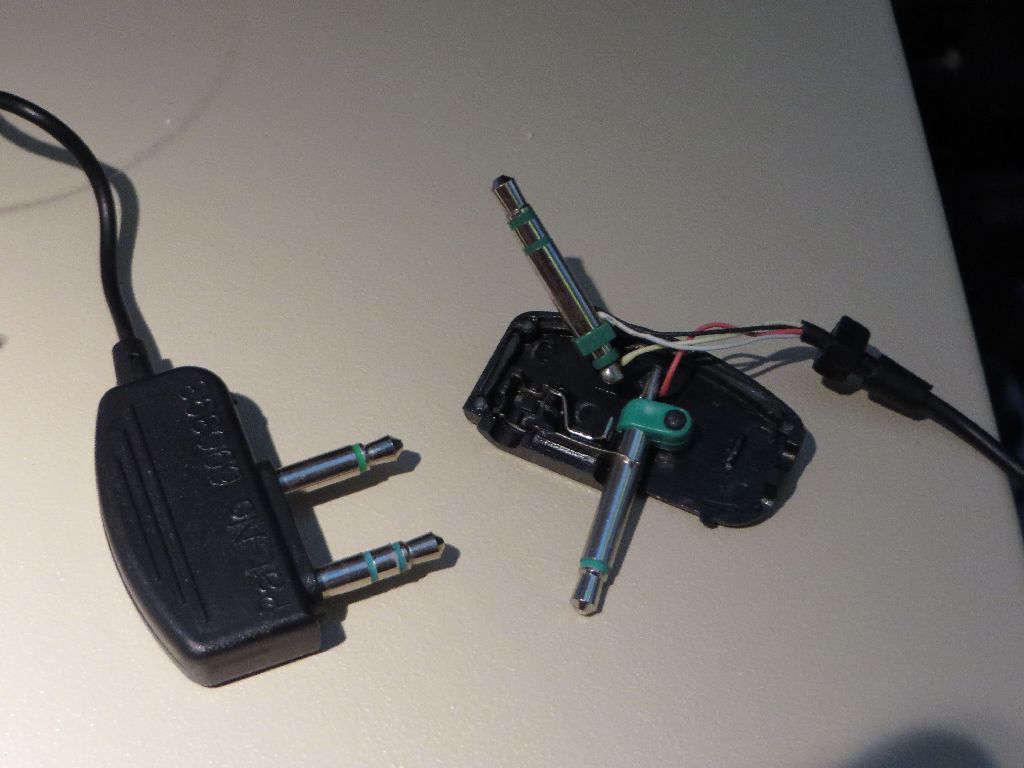
The graphics of the géovision are reasonably modern, but they loop in a standard program, alternating in Japanese and English version, without any customization option.
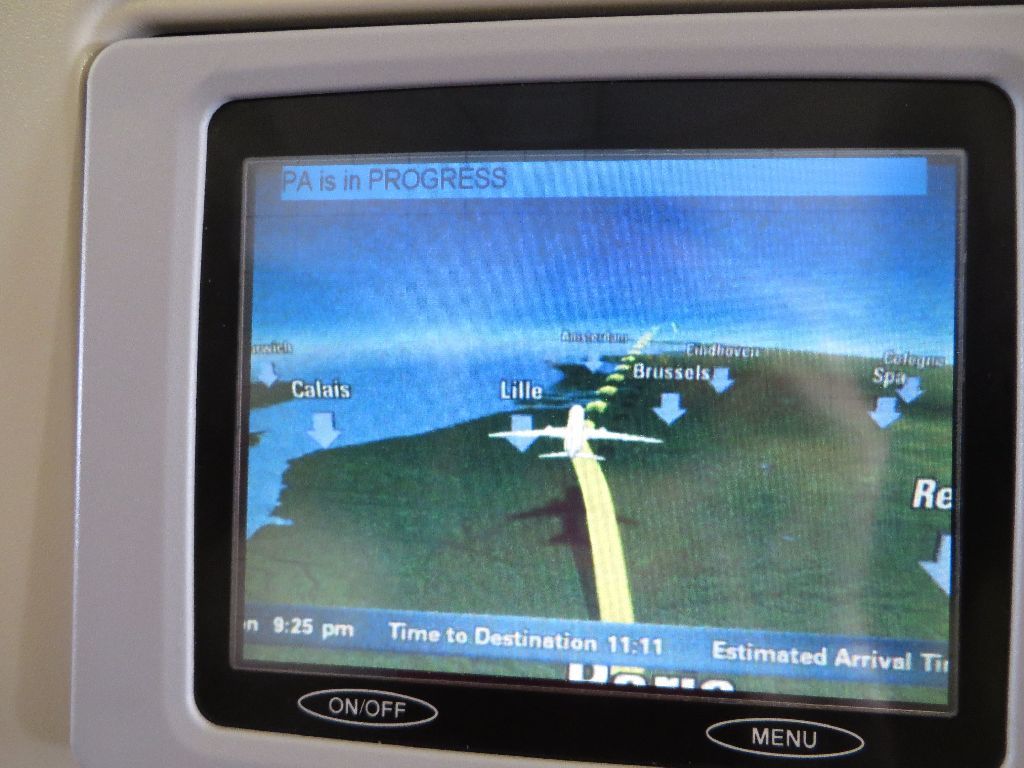
There was a front camera option though, providing the view more or less from the cockpit at takeoff and landing.
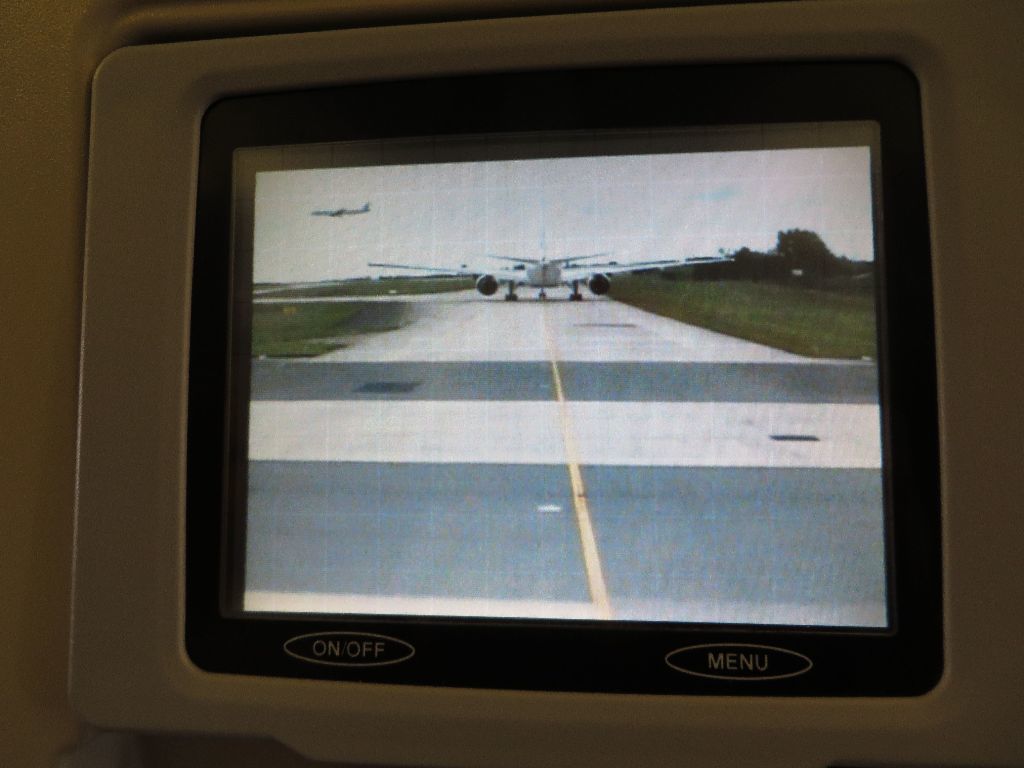
Too bad that the screen quality was so poor, but it was already much better than the first generation B&W cameras that are probably not manufactured any more.
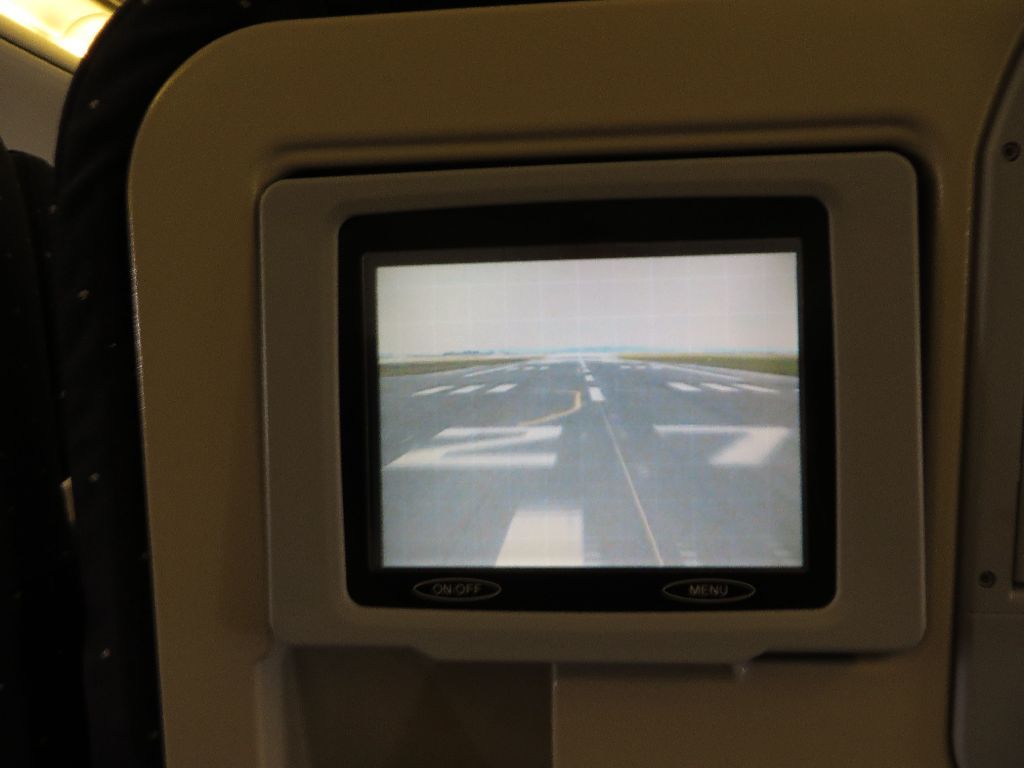
By now, you probably understood that the economy seat in AF's 77W was a plain disaster. It was even worse than in my memory of my PEK-CDG flight in 2012, also by night, which I had compared to that of MU in the return CDG-PVG flight. AF is similar in that respect to some low cost or charter airlines: the discomfort is acceptable only if the ticket is cheap enough. There was no miracle: we could have made the first leg of our trip on other airlines and/or in an A380, but it would have been much more expensive in airmiles. When you travel cheap, you have to pay for it in non-monetary terms, and I knew it when I booked these tickets.
The cabin being what it is, what about the FAs, who constitute a notorious lottery, where the prizes range from the very best to the worst ever. Well, we got the first prize on that flight, for the FAs were excellent. A very warm welcome in the rear of the aircraft by an slightly graying male FA (since we had boarded in priority, he was alone with us for a couple minutes), exchanging small talk about our final destination that he knew well, and service which was efficient and smiling by her female colleagues who served us.
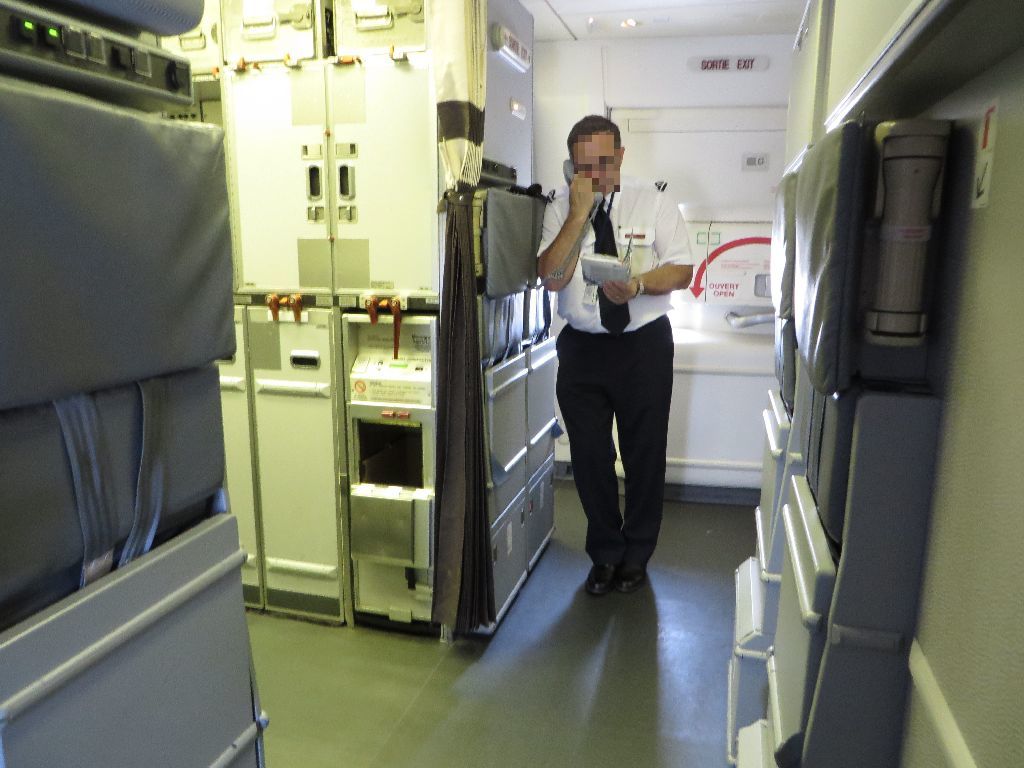
It is of course unbalanced to lambast the cabin layout in Y with fifteen telltale pictures, and congratulate the crew with a single illustrating picture. Let's add another one to illustrate the fact that they do not hide in the galley once the meal is served…
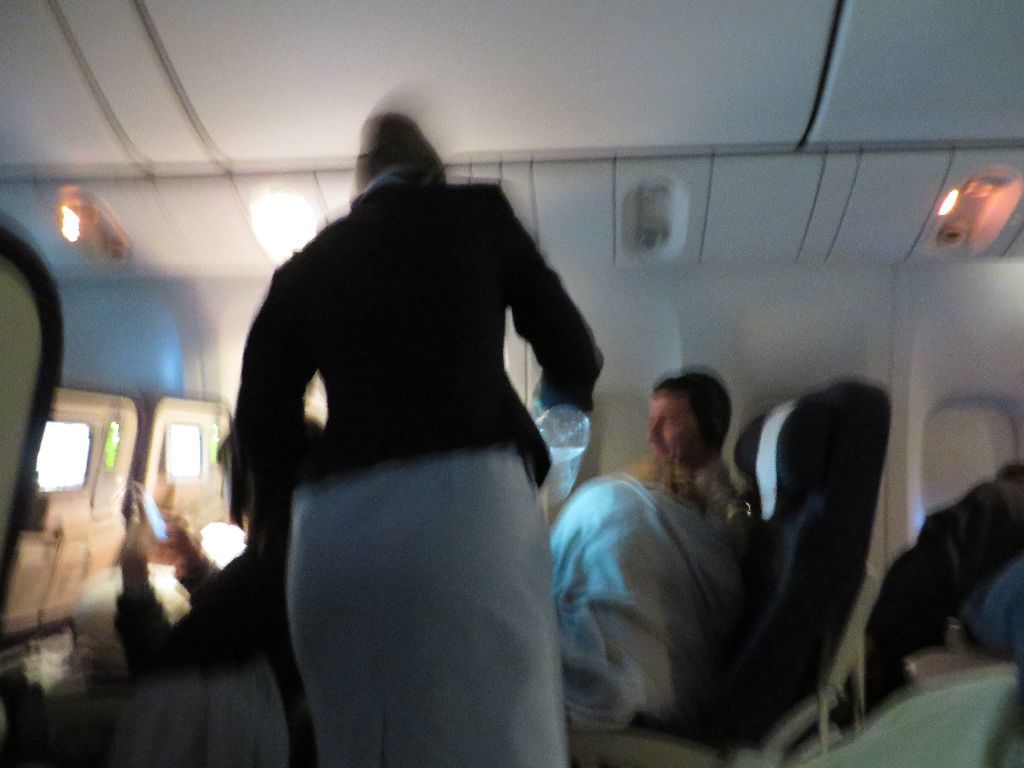
… or in the crew rest area, whose stairs are behind this door protect by a digicode,
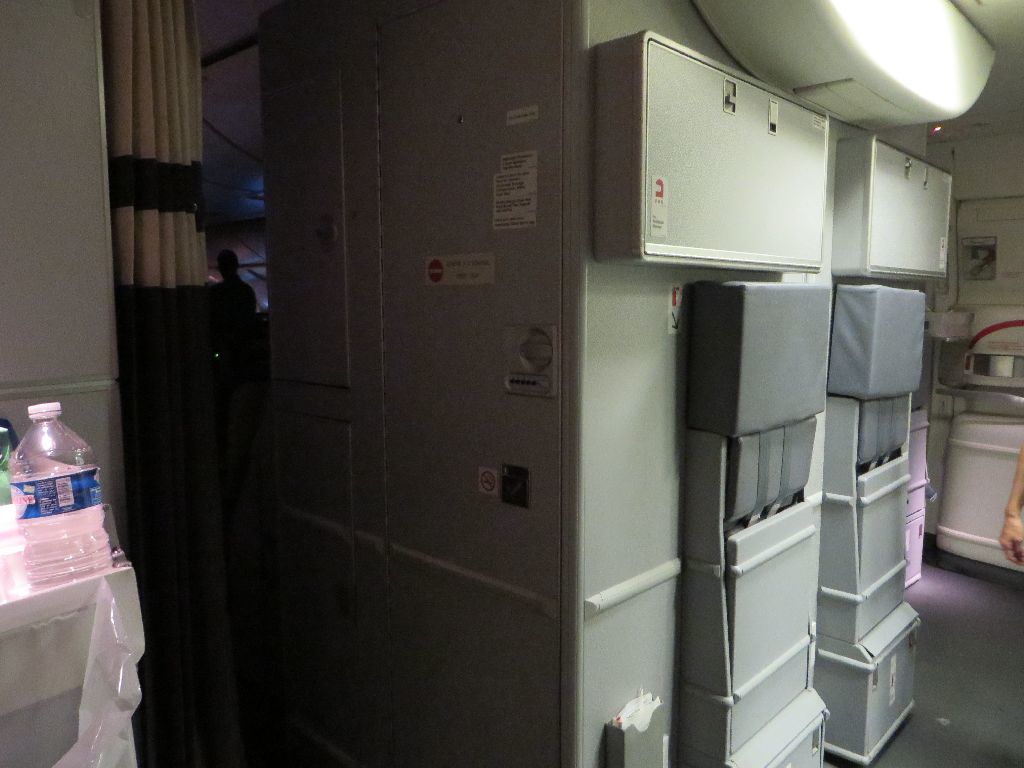
… in front of the rear galley:
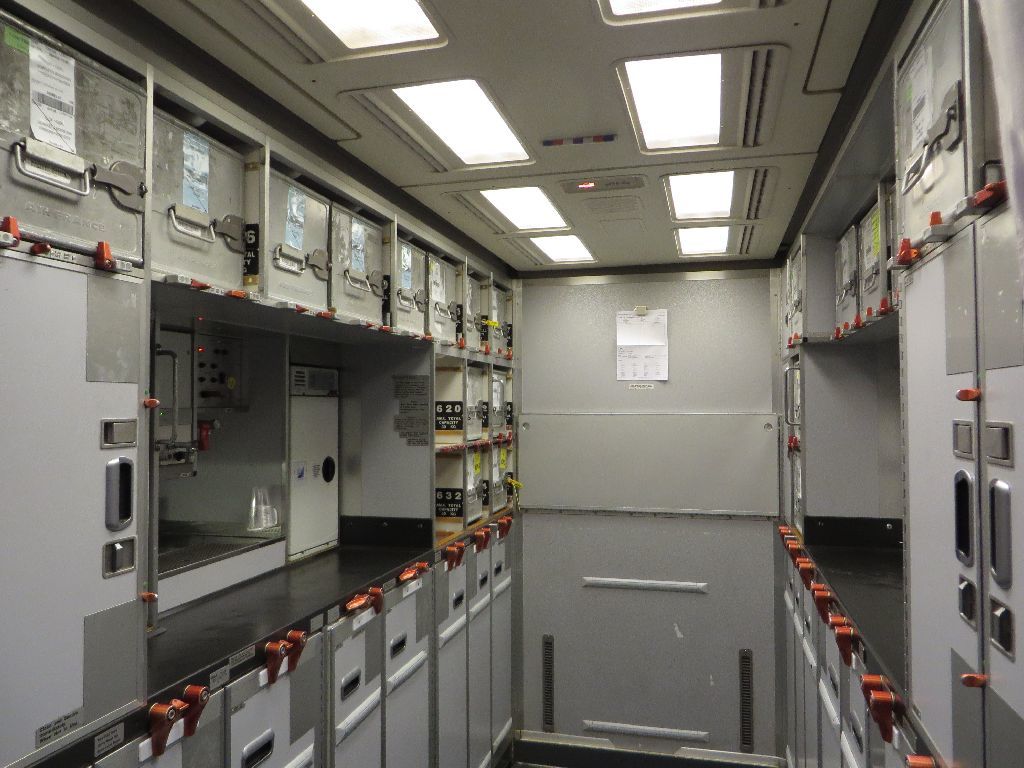
From the galley, the logical topic is the catering, and this is the menu.
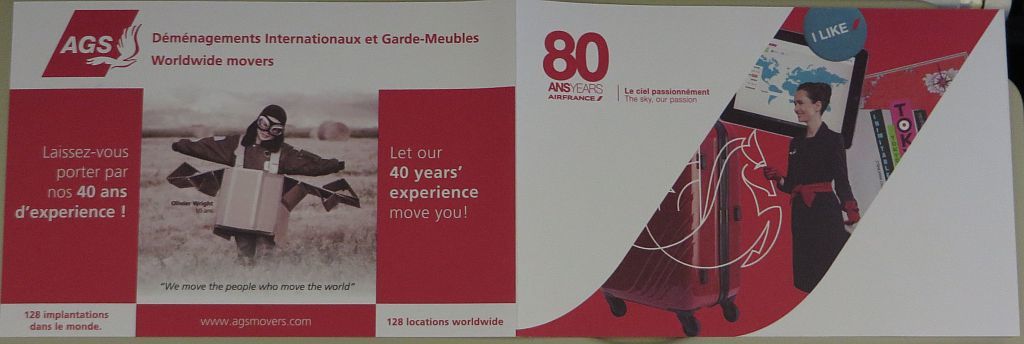
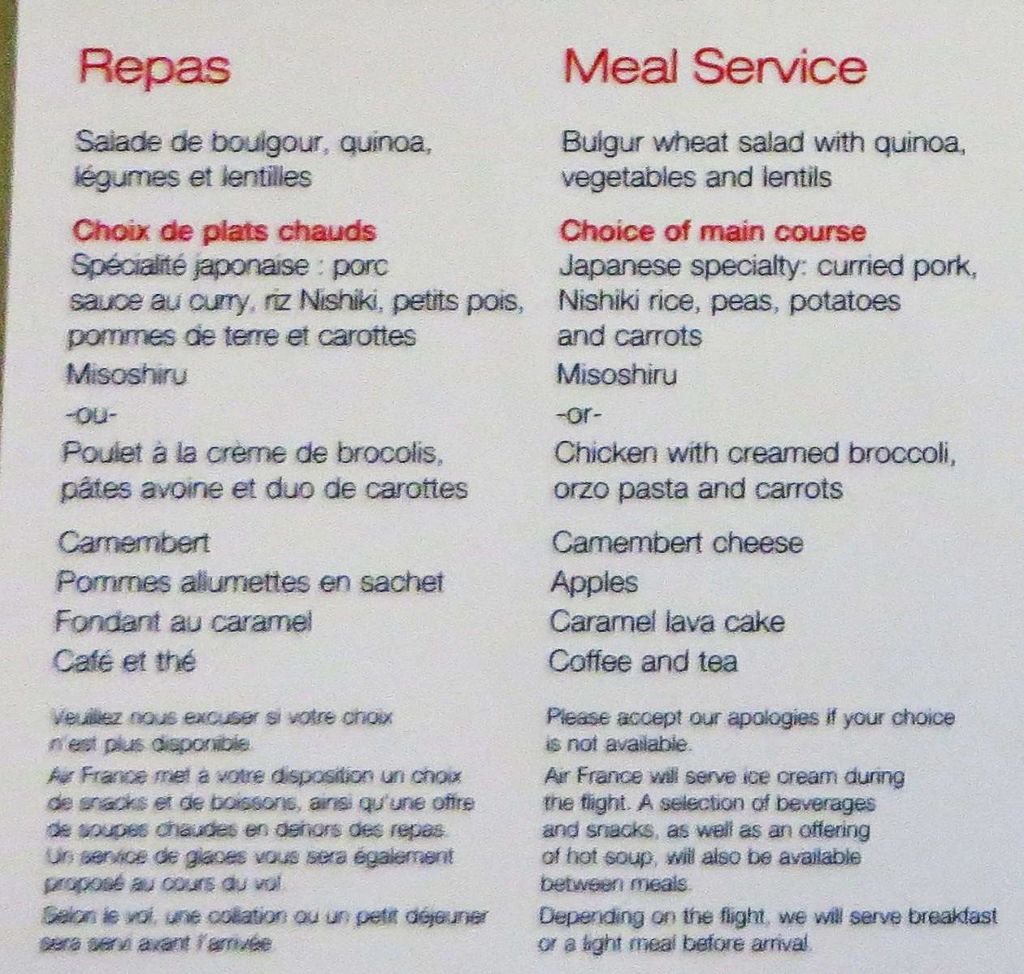
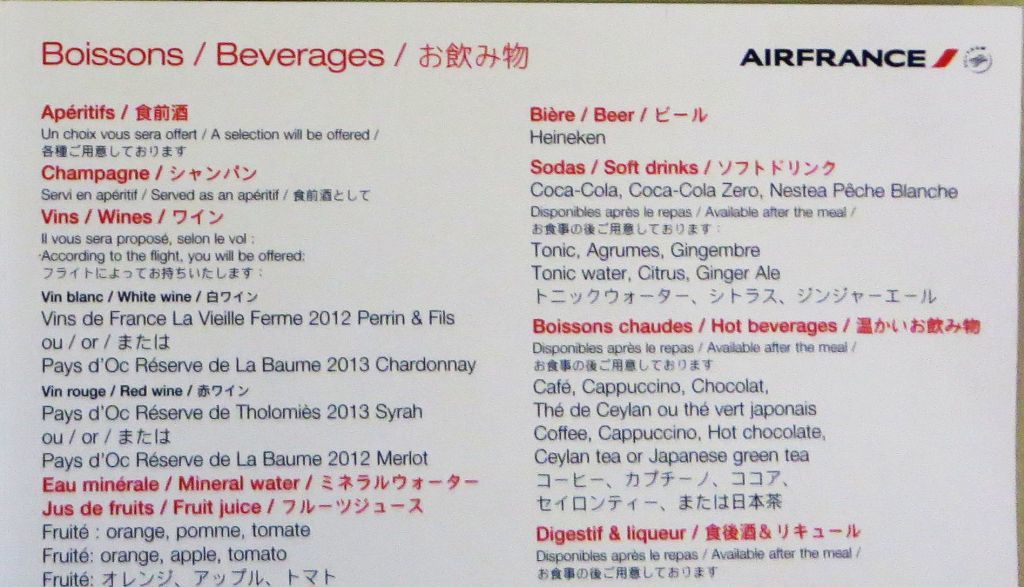
Mrs Marathon took bubbles, I did not, and we were too far from the window to take a picture of our glasses in front of it.
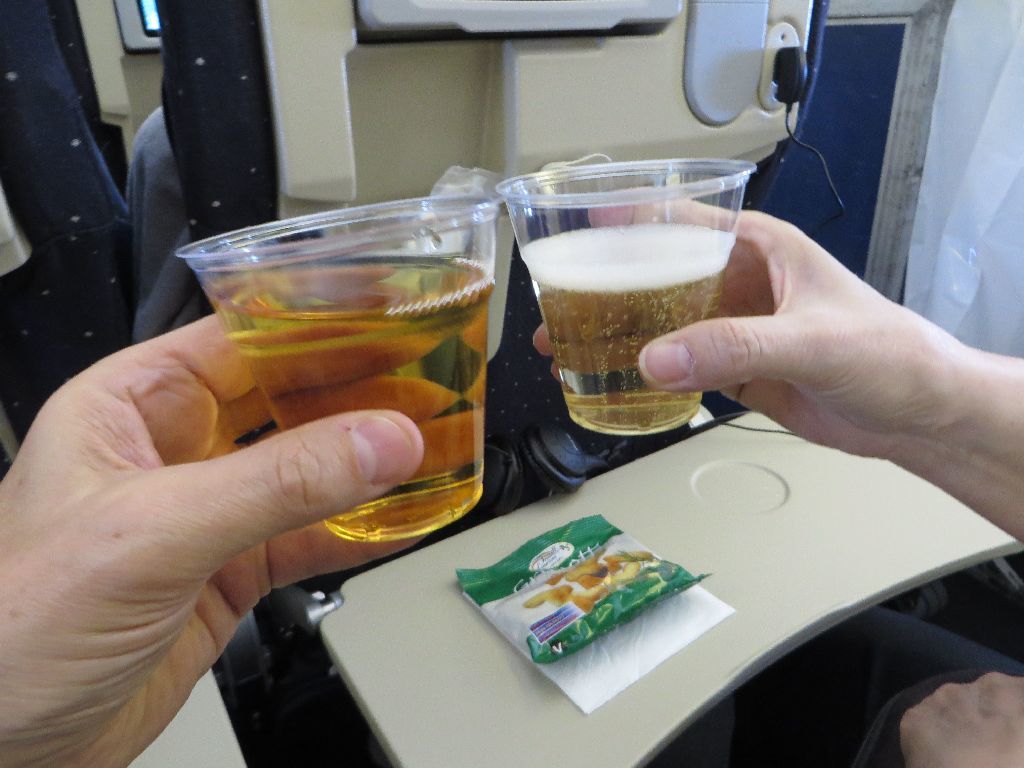
The contents of Mrs Marathon's plastic cup came from the bottle on the left, and she found it adequate. This is the end of oenological column of this FR, for Mrs Marathon drinks very little, unless you take my own consumption as a reference.
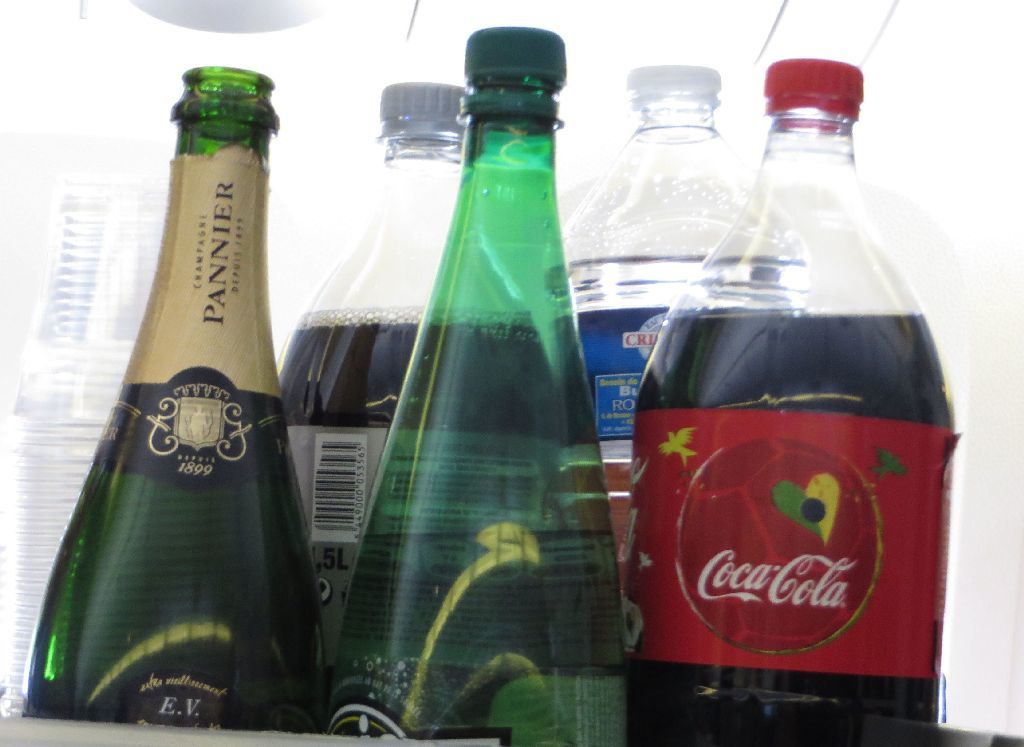
The Marathons spared no effort to prepare a comprehensive FR and chose a different menu (personal tastes were a dominant factor, actually), served like this:
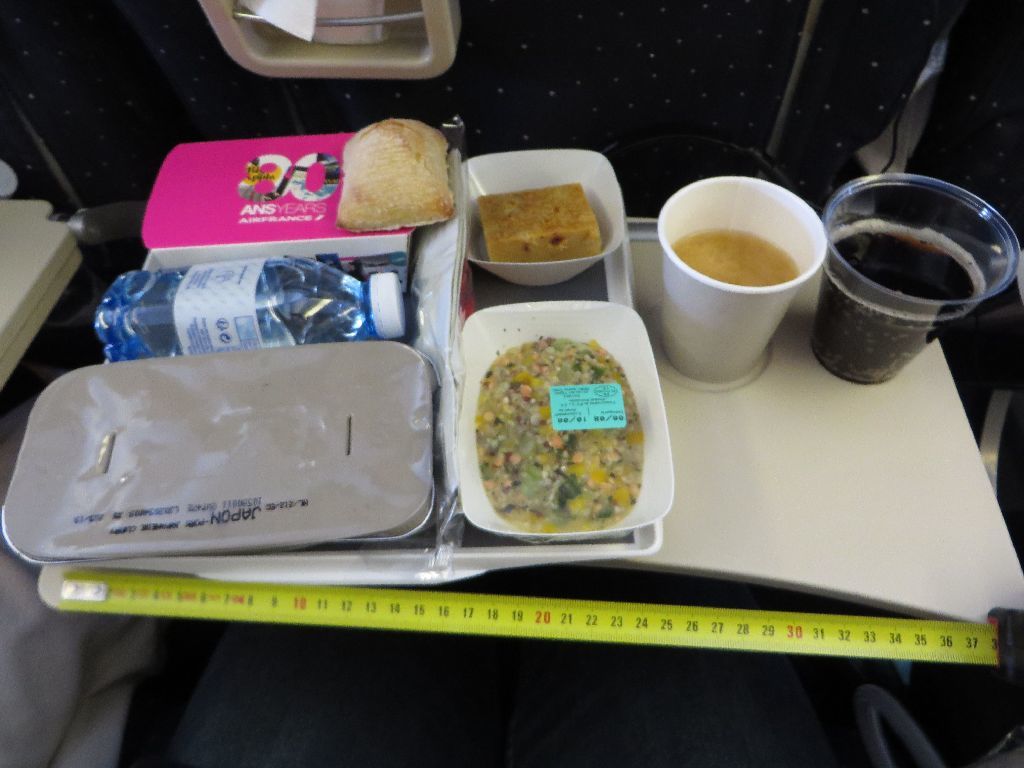
… and like that:
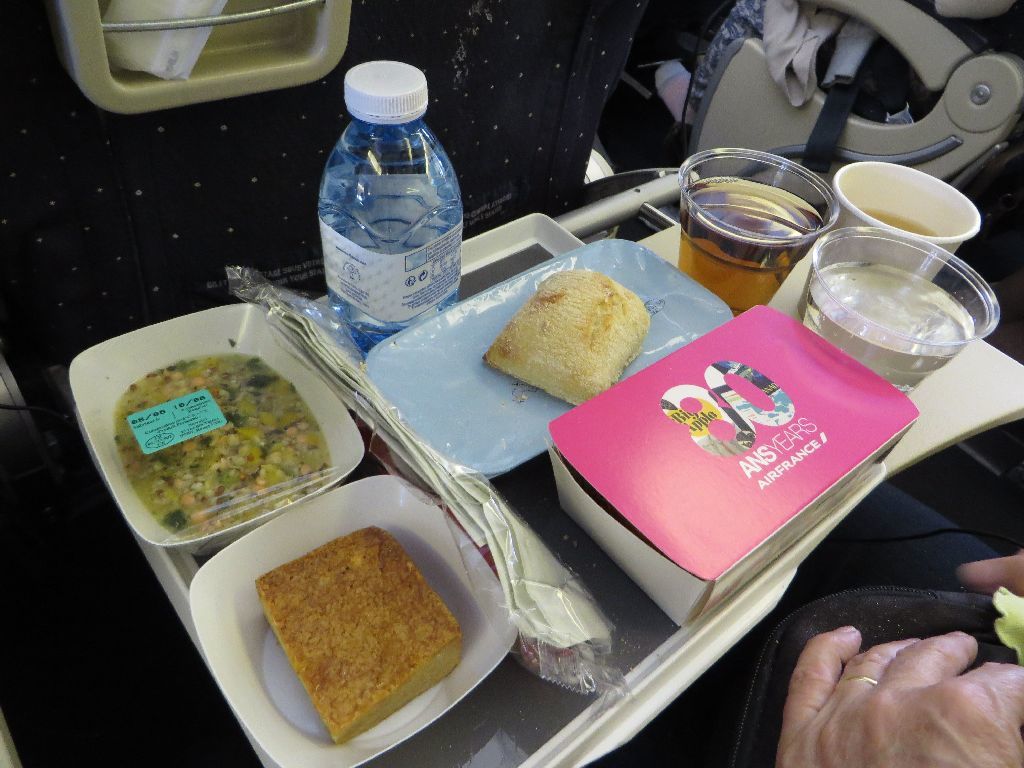
The bread was at room temperature, and there would not be much waste, given its diminutive size.
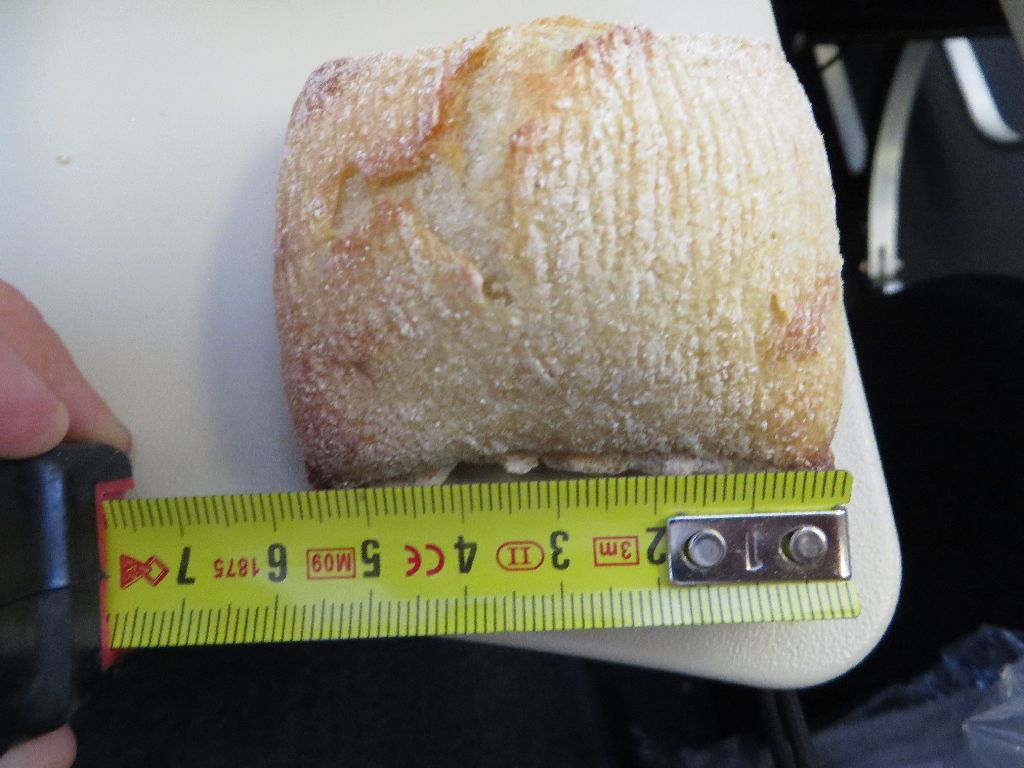
The Japanese hot meal (a curry), with the compulsory cup of miso soup. Mrs Marathon who asked for a cup of it too regretted the absence of algae (nori), and the FA agreed that that was missing. It was nevertheless a decent misoshiru, and that hot drink for starters was nice. It is very irregular choice, but I drank Coca cola with that meal.

The quinoa salad was unexpected (that ingredient has become very fashionable recently), but we liked it.
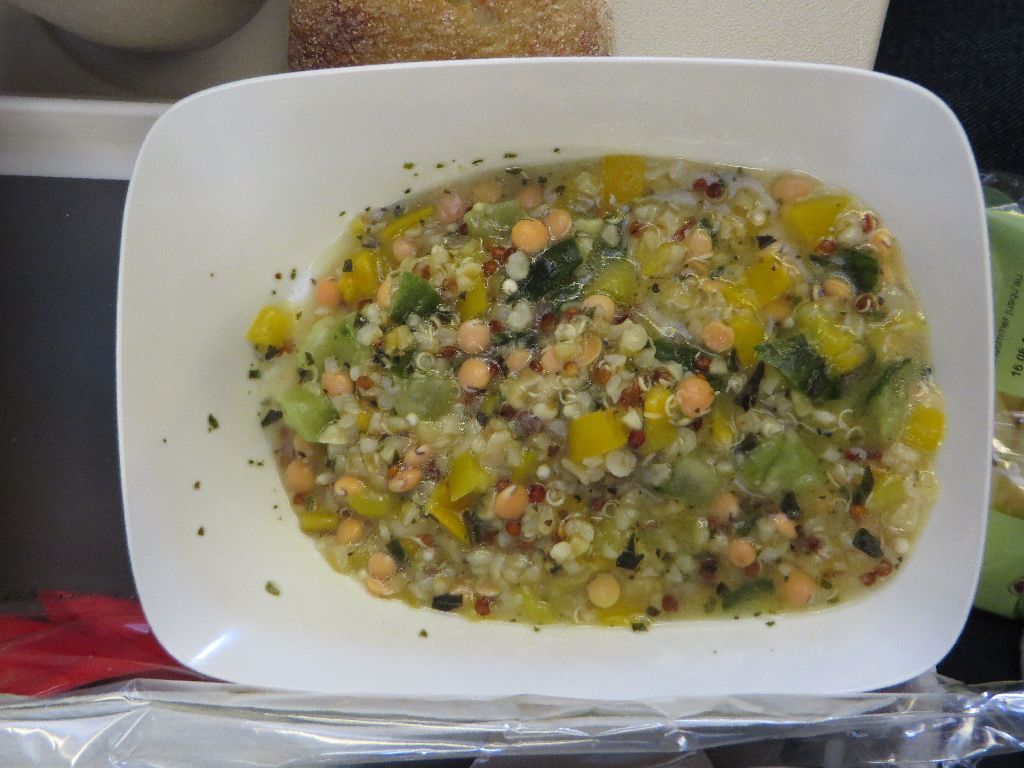
Overall, I found that this meal was very good (by economy standards, of course). Mrs Marathon also liked the chicken and pasta.
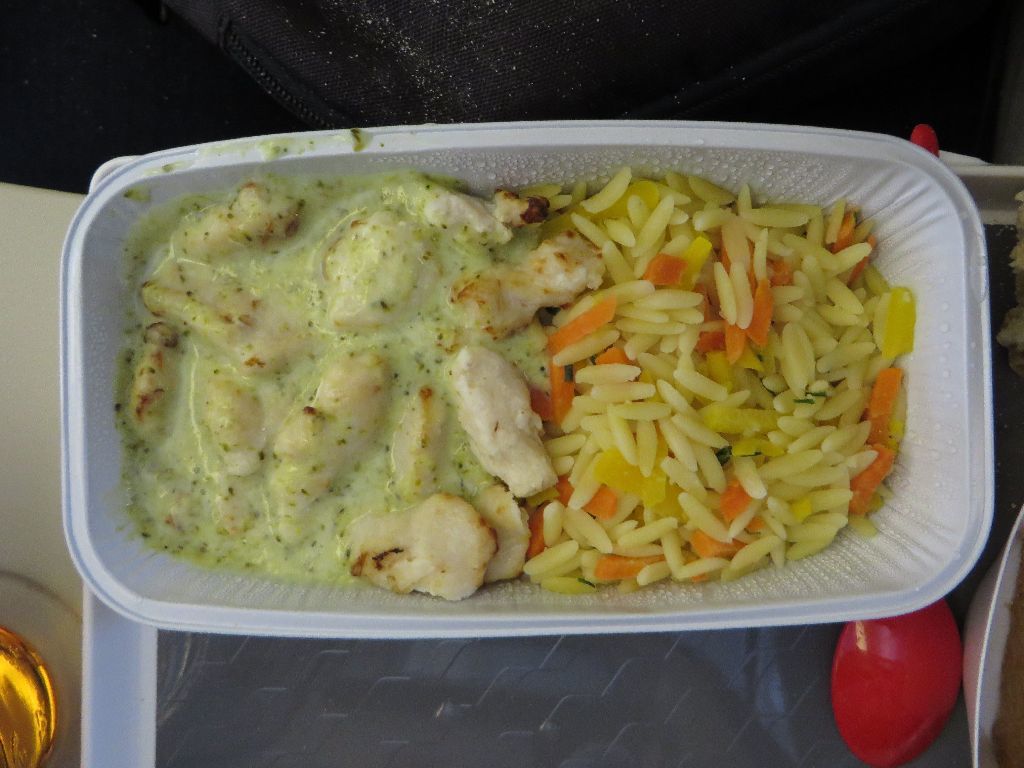
The so-called pommes allumettes (thinly sliced apples in roughly 5cm sticks) are made up of 100% apple, with an antioxidant added (ascorbic acid, i.e. vitamin C). That totals to more than 100%, but then, it depends of the amount of each percent :)

Now that the cabin darkens progressively, it is time to mention the toilets.

The one located in the tail section are longer than the others and seem all the larger that they are covered with mirrors, including the baby car table, identified with an obviously female pictogram.

The ashtray appears to have vanished!
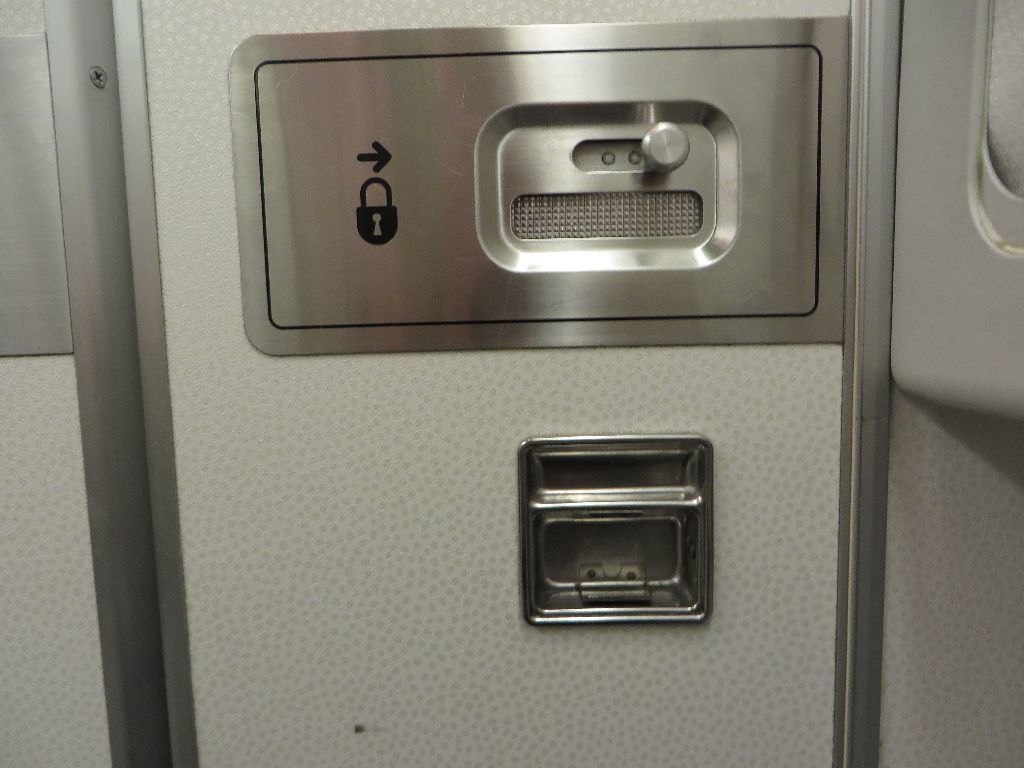
A Flight Reporter taught me that these adhesive seals (below, placed on the ceiling) are compulsory on any recess that a PAX could open, on flights serving the US, which means in practice on the entire long haul fleet.
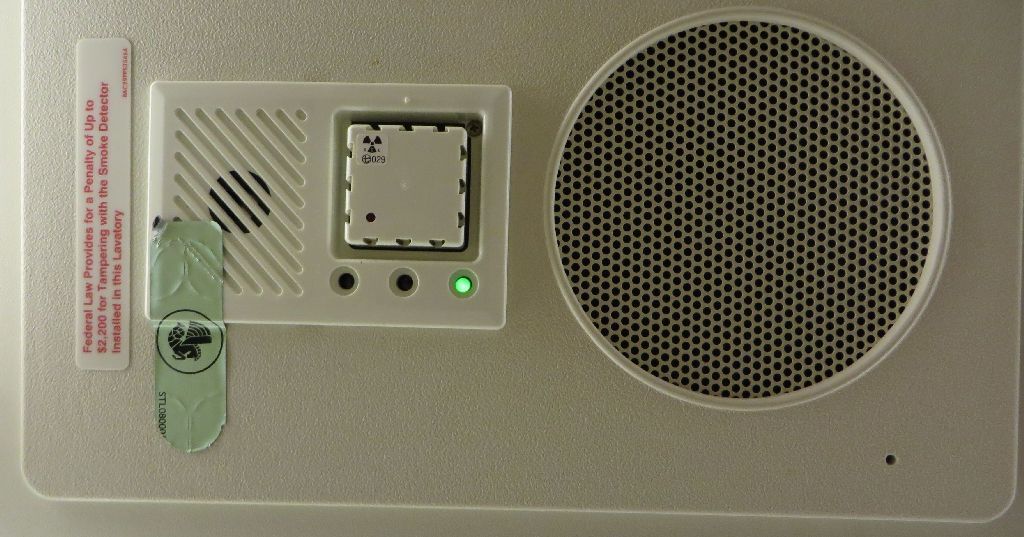
They will need to put some new ones on the sides of the toilet seat.

Non alcoholic drinks are available for self serve
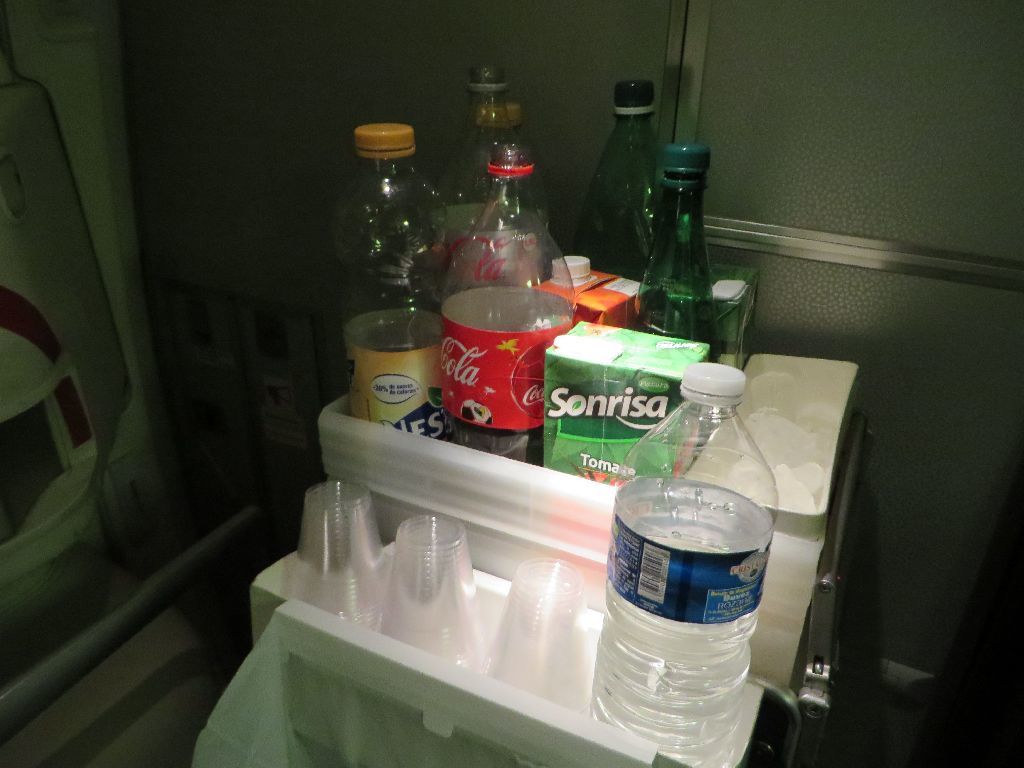
… and barely acceptable cheese sandwiches:
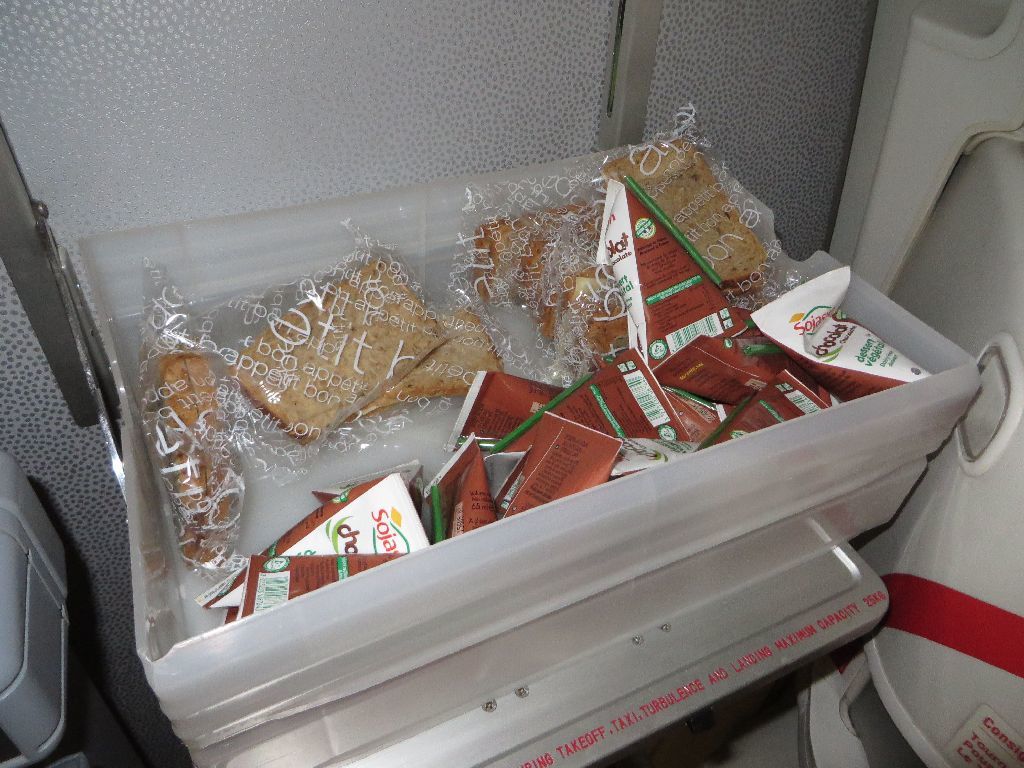
If you are homesick, there are also the cookies and the salty snacks served in economy on domestic flights. The small brown triangular packs are chocolate drinks.
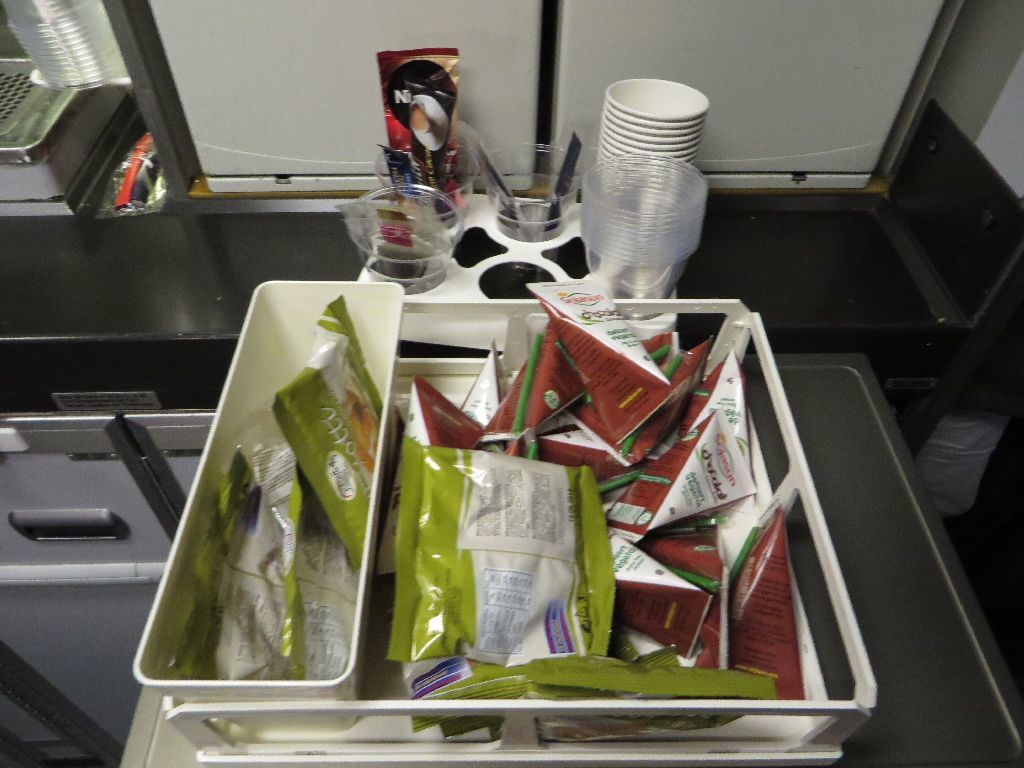
Dawn has arrived on the wingflex seen here from the window of one of the doors.
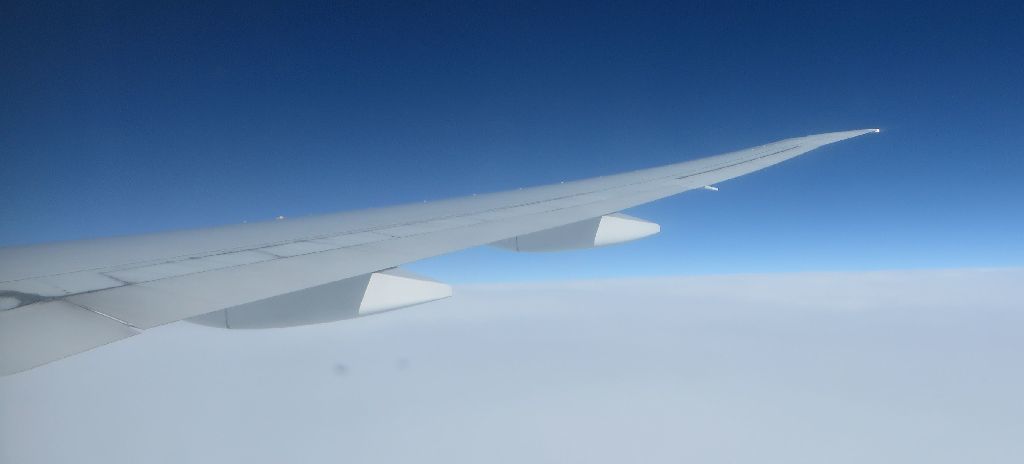
We reached this spot:
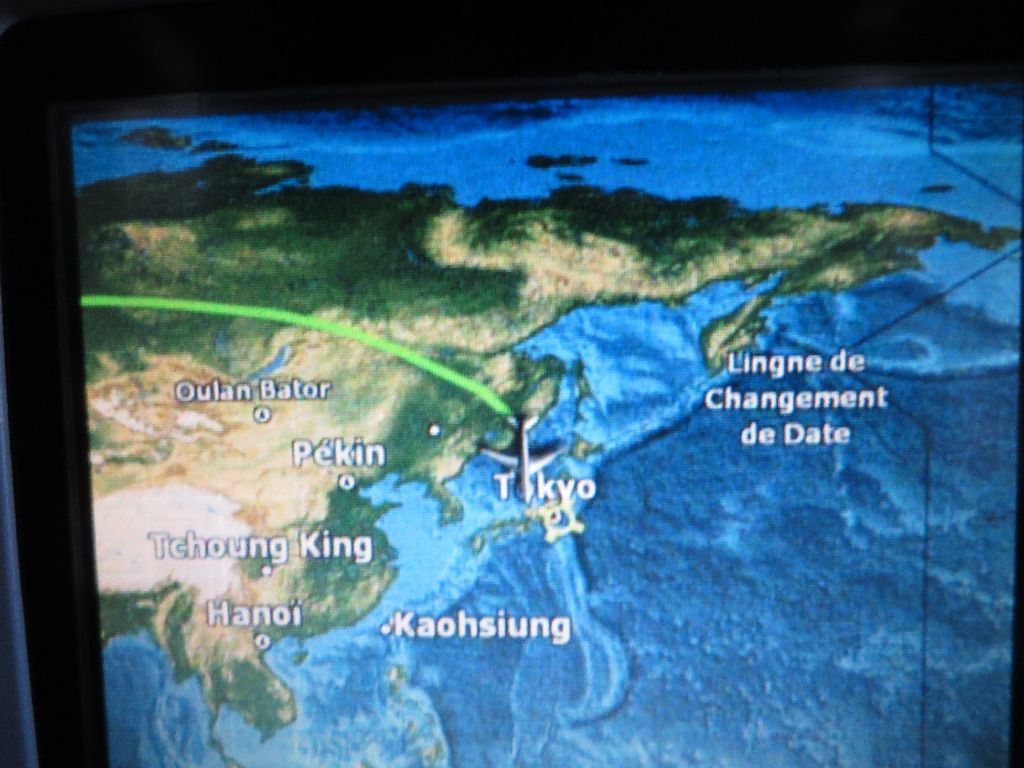
… and it is time to think about breakfast.
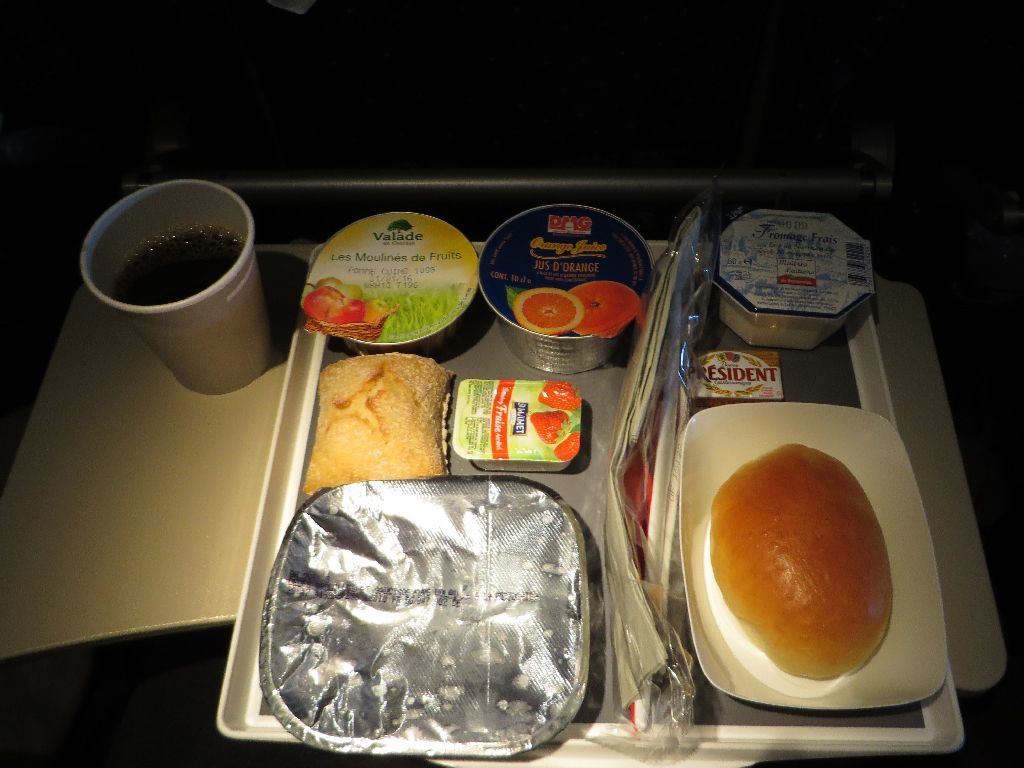
I found it OK, not more. Mrs Marathon did not like the apple with quince compote (because of the latter), and was not impressed by the thick tomato sauce which made up half of the lukewarm dish.
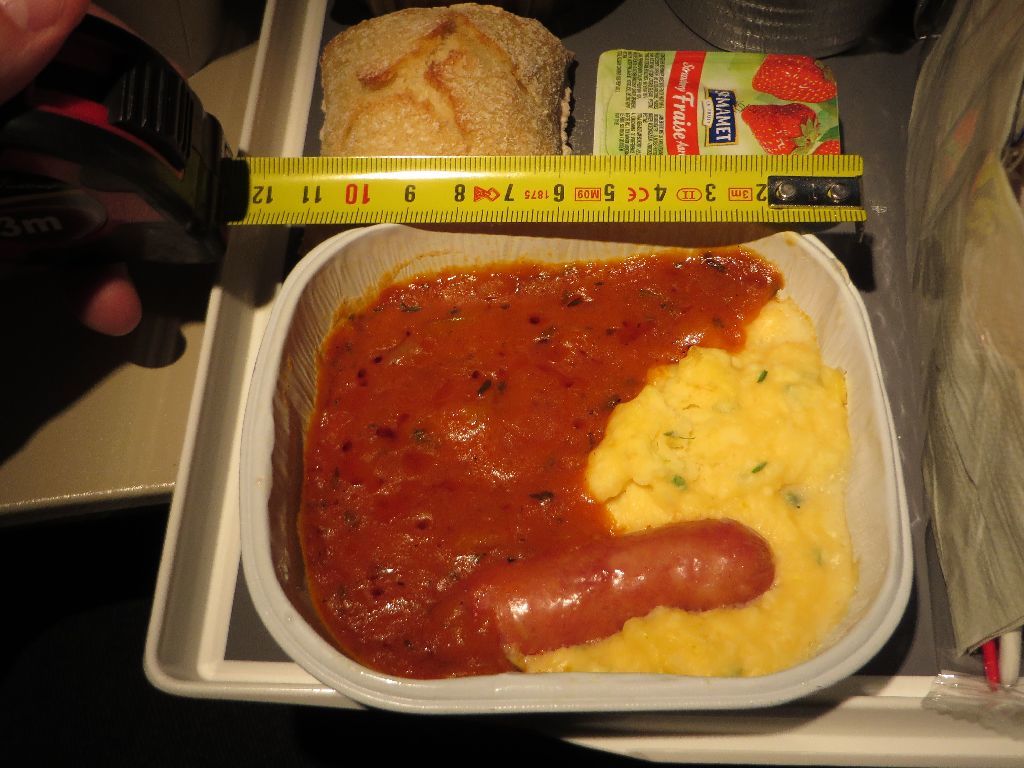
I remembered to take a picture of the safety card at the last moment.
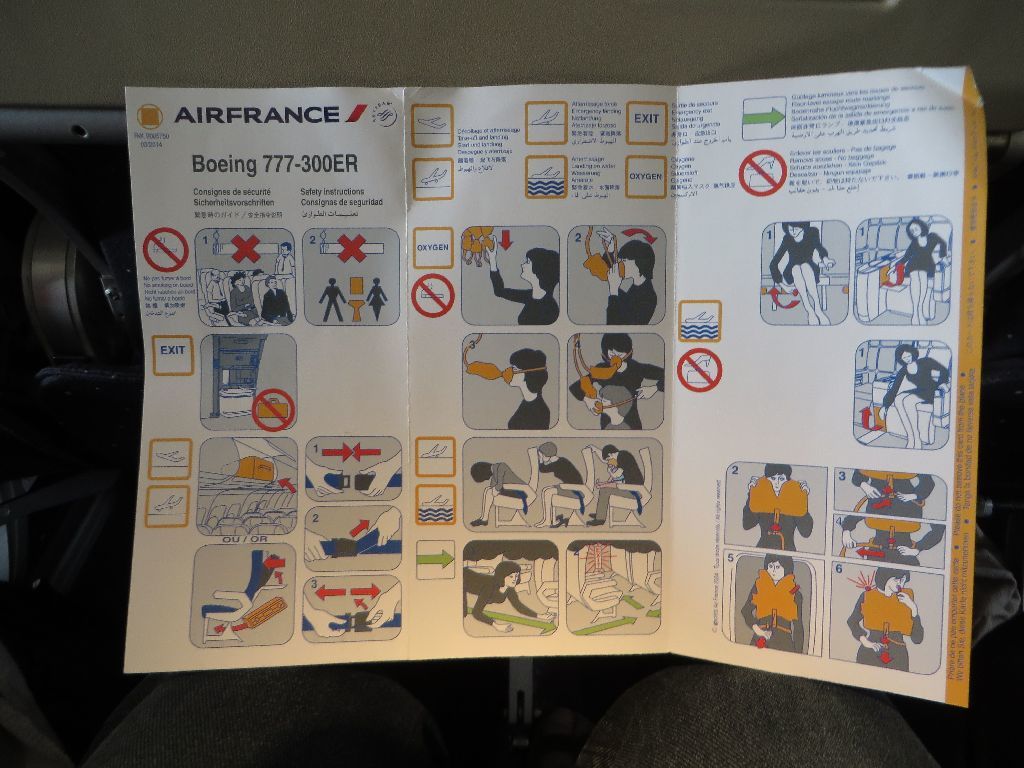
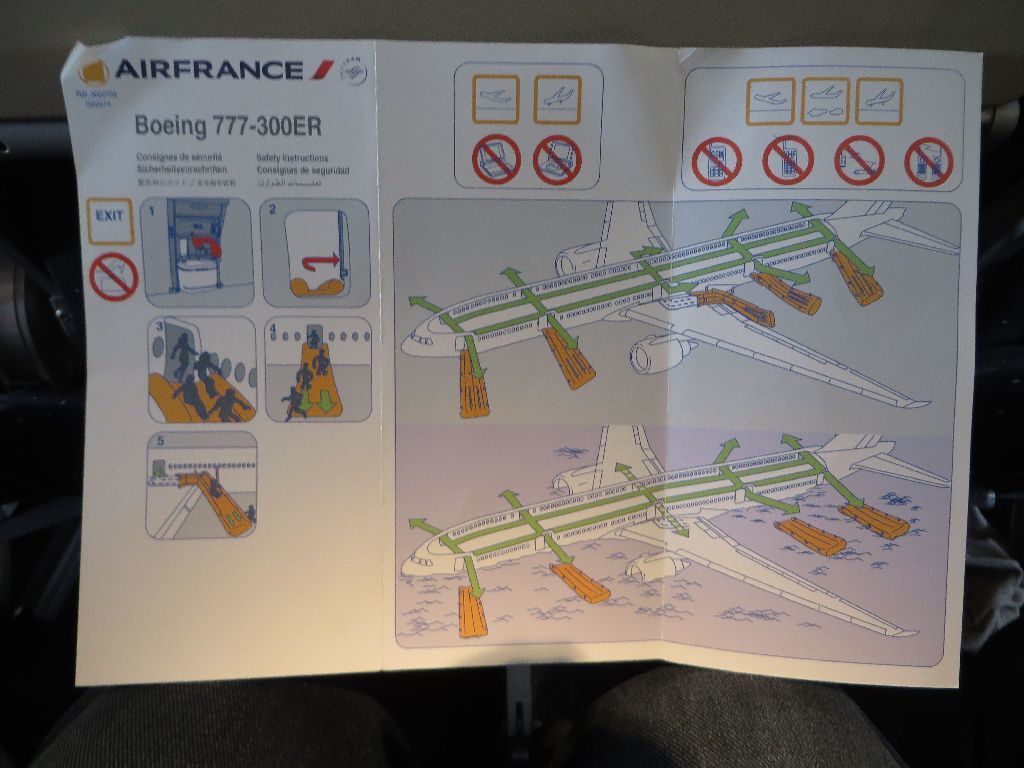
The cloud ceiling is very low in Tokyo and I am not at the window, but the front camera option provides a decent view of the landing. The plane was already 12 minutes late here.
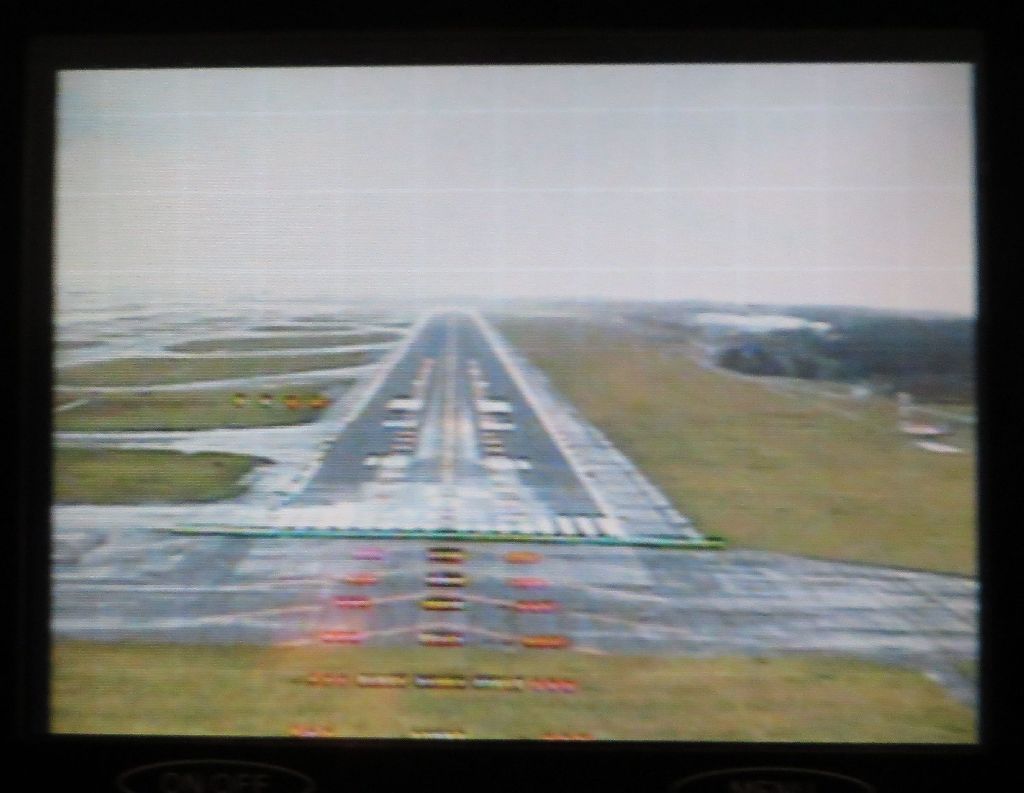
A view of the aircraft after leaving, thirty minutes behind schedule.

The tarmac is full of puddles, not by chance. Typhoon Halong had just crossed through Japan, where 500 flights were cancelled the day before, and 300 that day, probably mostly in KIX (and neighboring airports) where connecting to our next flight would have been a problem, for this is exactly where that typhoon hit the Japanese coast.
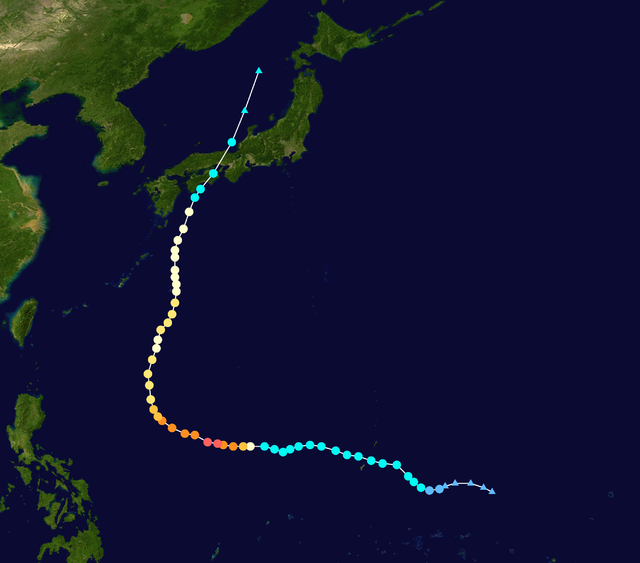
We went up an escalator, which provided a decent view of the aircraft.
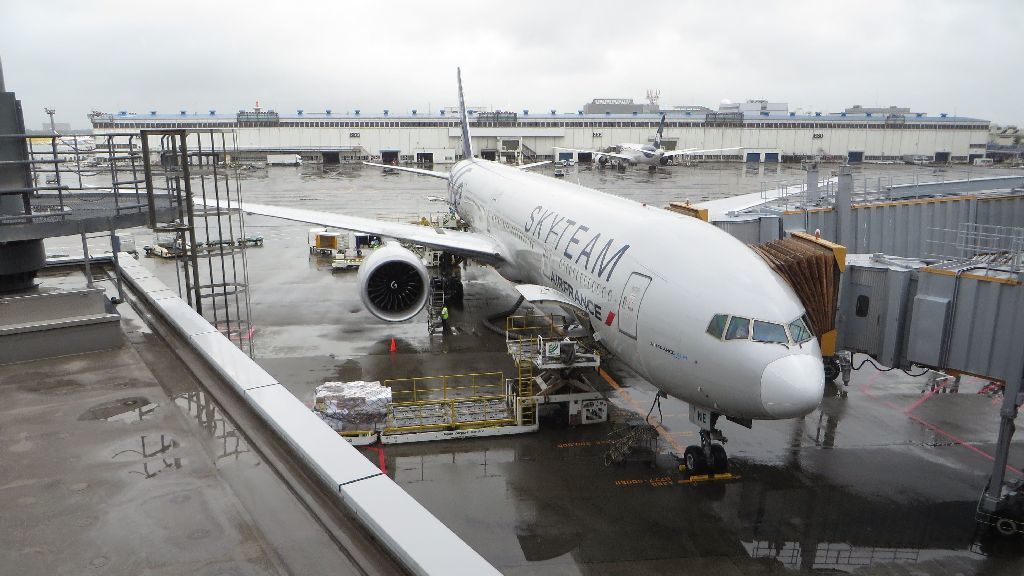
Some staff were waiting for connecting passengers, including us. A charming woman took us in charge: I only had time to take a couple pictures of planes on the way, walking at a brisk pace. This is the area were Skyteam flights are gathered, and with no surprise, we find two VN and a KE aircraft, on one side.
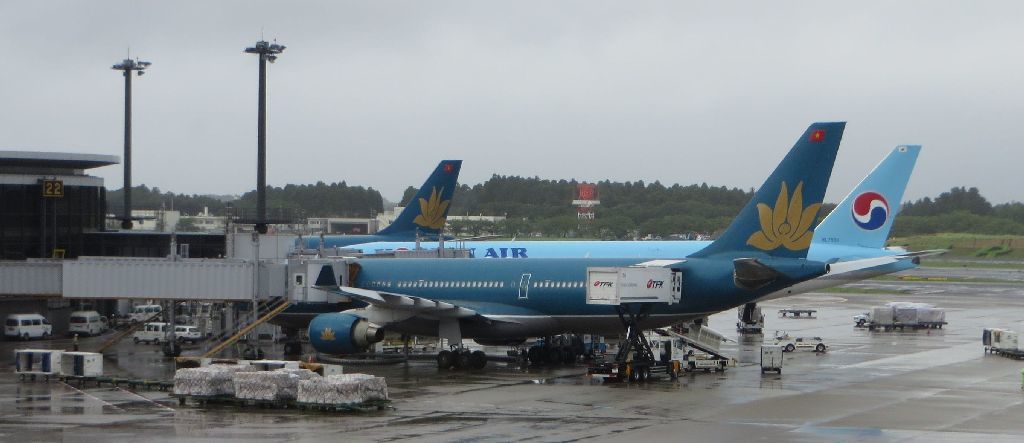
There would be the reverse later: a VN aircraft between two KE ones.

An Air Calin A330,
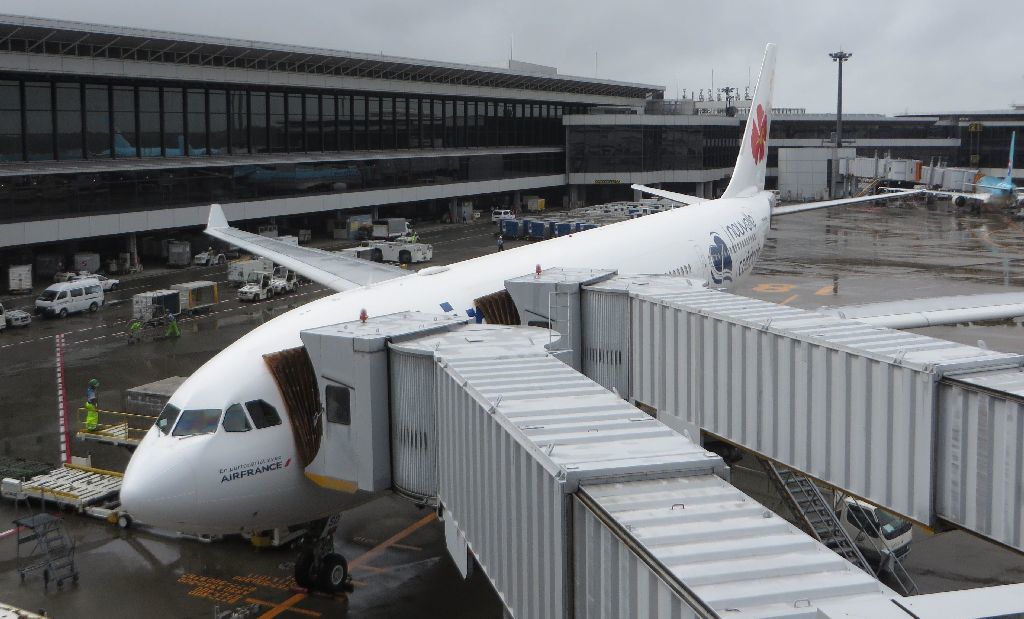
And a DL 757 with another taxiing behind, seen from the lower Departures level. The Americans seem to enjoy flying above oceans in single aisle aircraft (NRT is a regional hub for DL, but they fly 738s to regional destinations like Guam from there, like Guam).
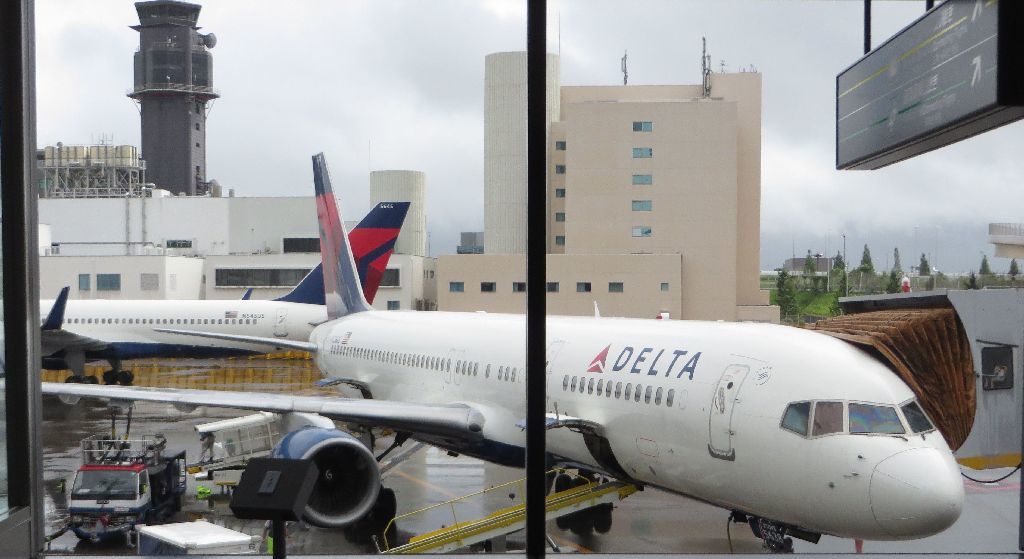
Being guided by a staff made serious plane spotting impossible (I would have ample time later, with equally decent views of the same part of the airport), but that was going to be a privilege, for she made us shortcut like VIPs an incredibly long line at the security check for connecting passengers
Being shepherded by an airport staff made plane spotting nearly impossible (but I was to have ample time for that later, from areas having an equally good view on the tarmac), but that was a significant plus, because she made us short-cut like VIPs a gigantic line waiting at the security check for all transit passengers. Maybe it had to do with our status of connecting passengers, with checked luggage : they would doubtlessly make it to the next plane, that we could delay if it took an inordinate amount of time to make it to the boarding gate.
She is the one who tells be that our checked luggage will not go all the way to our final destination.
A last look at the white nose of AF's 77W

There is nobody at the Skyteam transfer counter, there will never be anybody, and we do not have the BPs to the next flight…
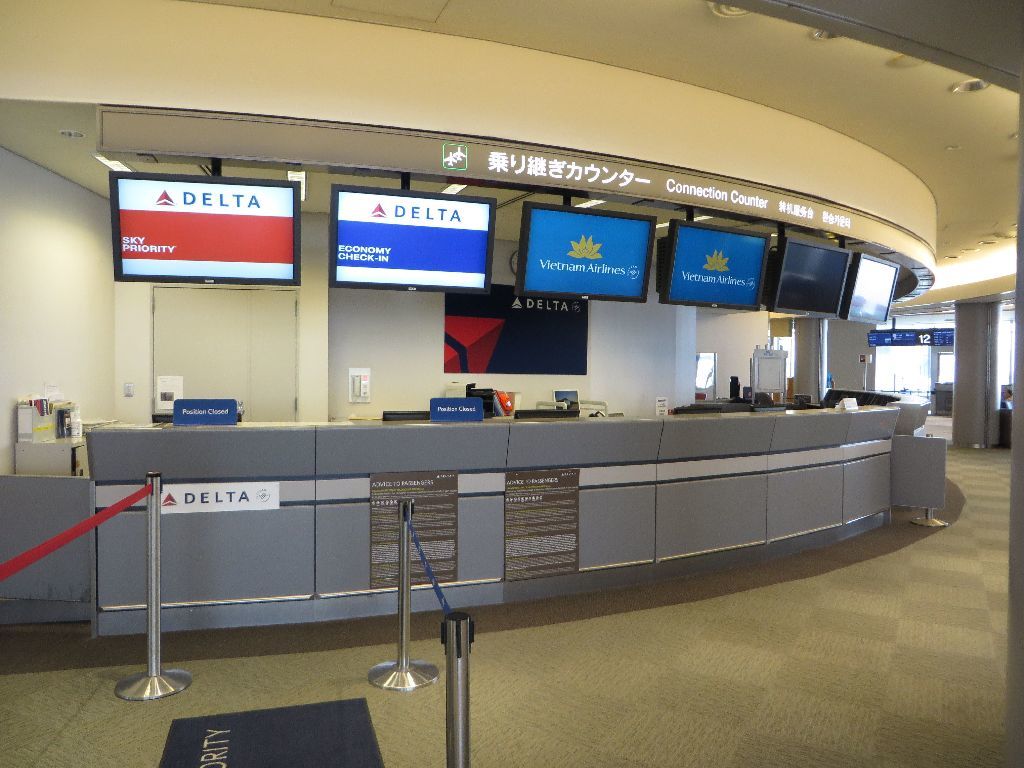
A simple search of my French language FRs would tell you that the next stop is DPS, so there is no need to make it a riddle like I did in the other language. How long it will take me to translate the next FR is a riddle, though.
Meanwhile, since my routing is through Tōkyō, ans although it is a connection only, I propose a new tourist bonus on a rather particular place in that city.

Few foreign visitors visit here, and none if they hold some official office, especially a political one. Yasukuni shrine is a focal point of the ever present rancor of China against Japan.
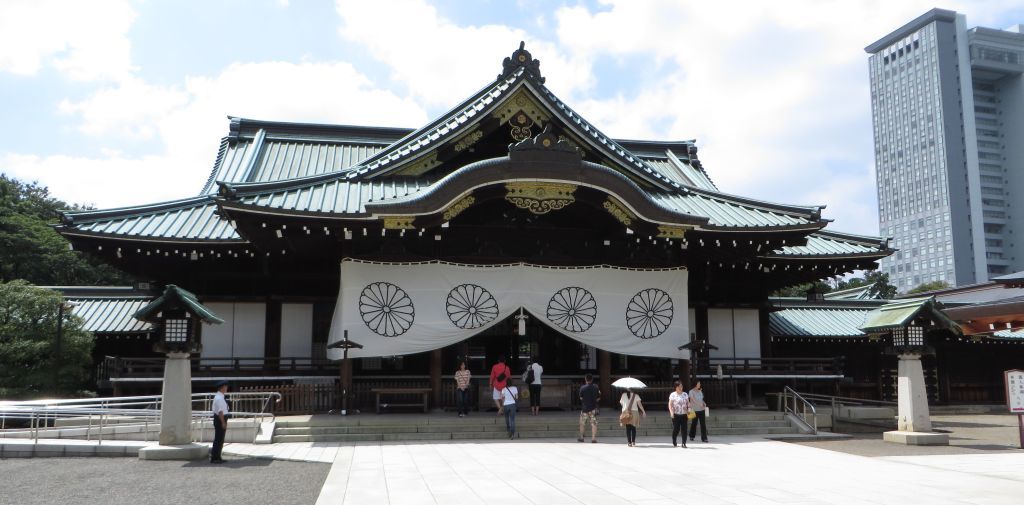
All countries have monuments commemorating those who lost their life for their country, but the devil is in the details.
First of all, Yasukuni has been created as a sanctuary for those who died for the Emperor during the 1867 Bōshin civil war. They were sanctified, i.e. became gods in the Shintō religion, like if the Western soldiers killed in action had become saints. You do not de-sanctify a dead in Shintō in more that you de-canonize a saint in Christianity.

Second, Yasukuni is not a sanctuary for the fighters only, but for all the victims of Japan's wars since 1867. The more than two million kami 神 (spirits) in Yasukuni include therefore the souls of many civilians, sometimes against the will of their kin, and also some embarrassing dead celebrities.
In 1978, Yasukuni's Shintō priests sanctuarized around a thousand Japanese who had been sentenced to death in the Tōkyō trial for war crimes. These criminals, especially the seven belonging to Class A (political leaders and senior military leaders judged to be responsible for the war), are a regular cause of friction between Japan and China, each time members of the Japanese government participate to a ceremony at Yasukuni.
The Americans imposed the abolition of the state religion status of shintō, its priests can easily brush off all demands to de-sanctuarize these criminals. This development reinforced Yasukuni in its status of the stronghold of the Japanese extreme-right, which much like its European counterparts do not hesitate to rewrite history and negate the Japanese war crimes.
In this context, the Yūshūkan, i.e; Yasukuni's museum, is a surrealistic museum of Japan's military history seen through the prism of Japanese revisionism.
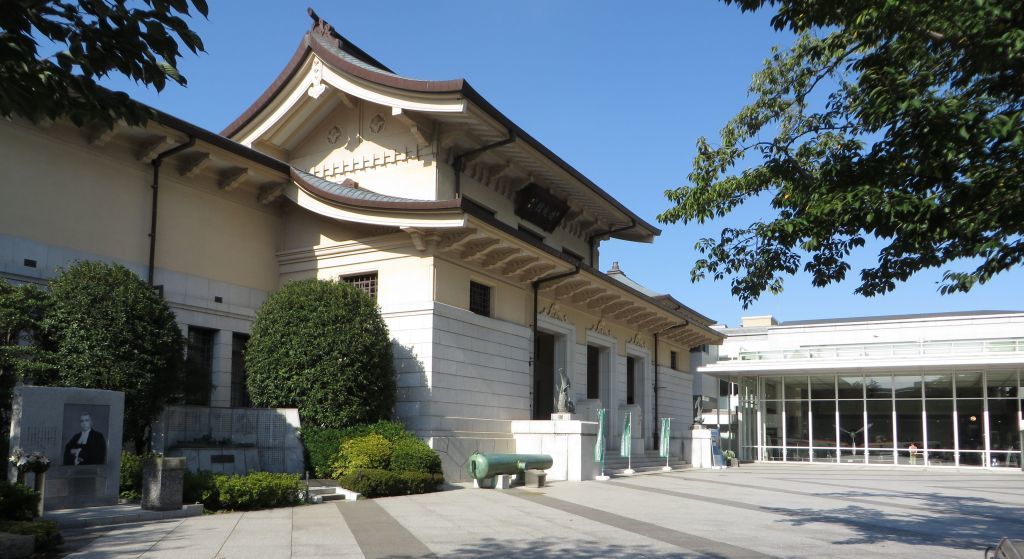
The tone is set right in front of the building, where alongside a classical statue of a widow and her orphaned children stands a monument to Radhabinod Pal, the Indian judge at the Tōkyō Trial, who in a single dissenting opinion found all the accused non guilty of any count. The thick volume where he had expressed his opinion has long been banned in occupied Japan, as well as in the US. The small Plexiglas box next to it contains printed bilingual copies of a vibrant tribute of the chief priest of the sanctuary to this judge.

In the entrance hall, this aircraft is one of the very few intact Mitsubishi Zero, the famous carrier capable fighter which surpassed by far all its rivals during most of WWII in the Pacific theater.
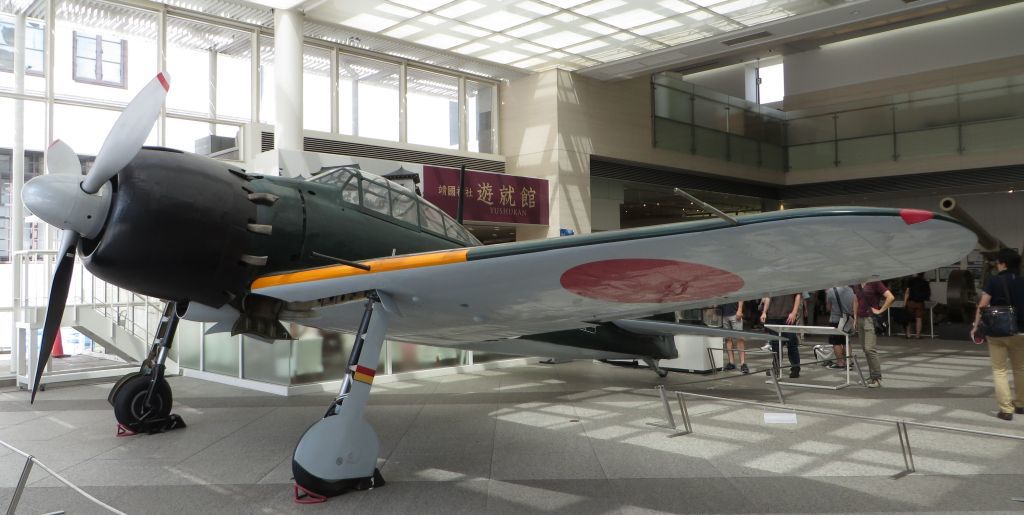
Its exceptional speed, maneuverability and autonomy features owed a lot to its complete lack of armor and structural reinforcements: weight saving had been preferred to the protection against machine gun bullets. The pilot's excellent chances of survival were due to the fact that his enemies had little chance to aim, until the balance of forces turned overwhelmingly in favor of the Americans. This aircraft was also used for kamikaze operations at the end of the war.
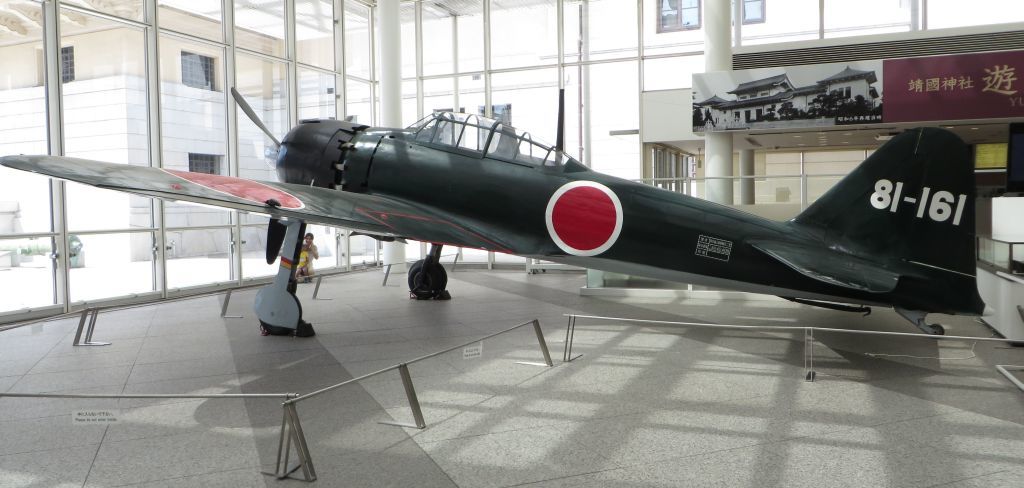
What striked me in that museum on Japan's wars was the place devoted to the kamikaze 神風 and their glorification, discreetly announced by the Zero in the lobby. The West remembered mostly the diving aerial attacks of suicide planes against ships, and forgot surface and submarine attacks. Ironically, the hardware exposed in the main hall of the museum is that which caused the least damage to the US navy.
The Ōka 櫻花 (Chrysanthemum Flower) was nothing but a missile guided by a human. It had no landing gear and was dropped by a bomber in the vicinity of the target. Its three rocket motors had nine seconds of autonomy each and could make it dive close to the sound barrier if fired simultaneously. The entire section ahead of the wing was a 1,200 kg bomb.
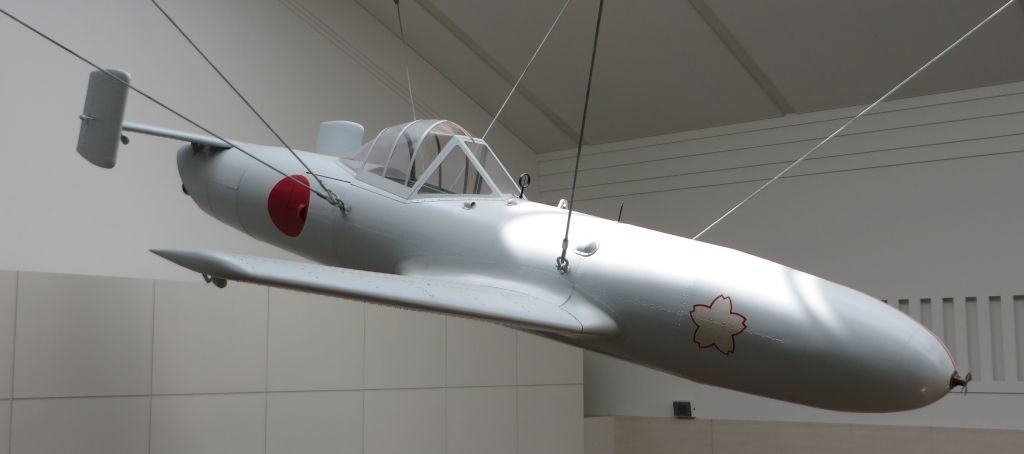
The Kaiten 回天 (Return to the Sky) were pocket submarines which were the underwater equivalent of the Ōka, i.e. torpedoes guided by a human. This is one of the Kaiten, next to a small Type 93 torpedo. Both used the same revolutionary liquid oxygen motor, which eliminated the bubble trails betraying the torpedoes propelled by compressed air.

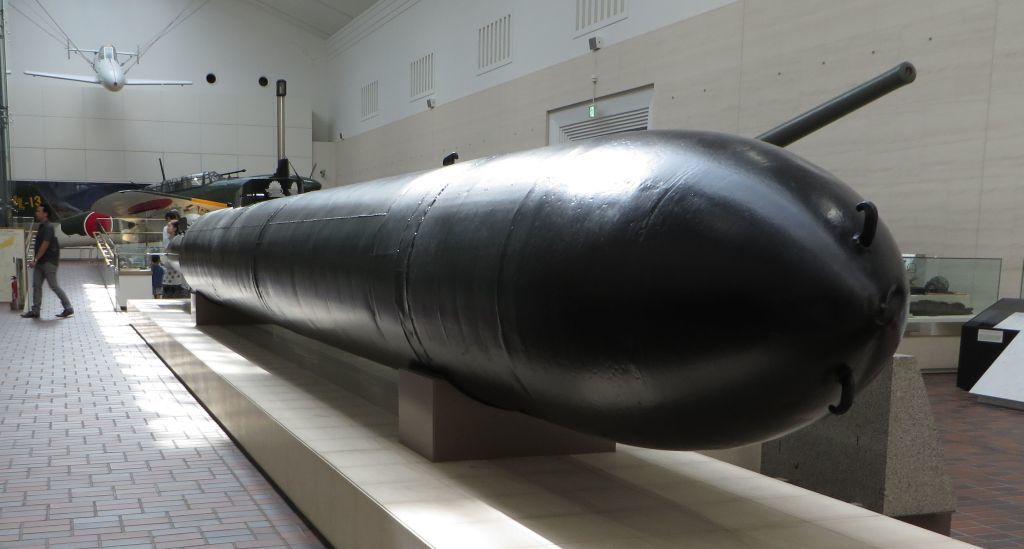
Even less known, this Shin'yō 震洋 (Ocean Wave) speed boat had a more conventional design. It ws not strictly speaking a suicide craft, because the pilot was supposed to turn back after dropping two mines and launching two torpedoes towards his target. However, he could not get away far enough before the explosions and very few survived.

The only European politicians who ever visited this place officially were in a delegation of the extreme right of various countries. Being a simple Flight Reporter, I could visit this place which symbolizes the absence of reconciliation between two countries that I know well, and a vision of History that I do not share.
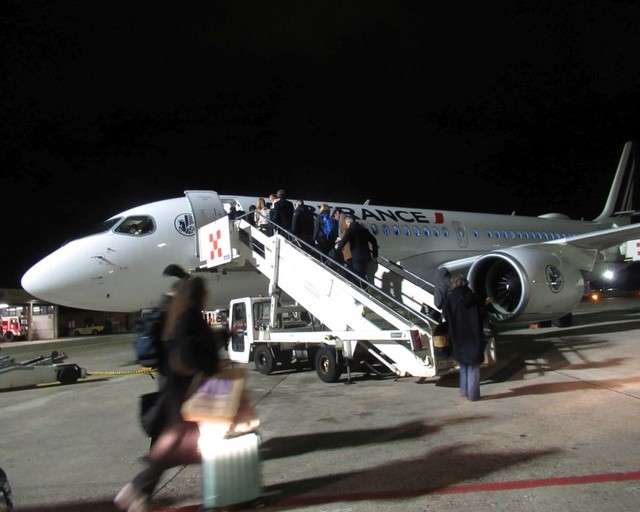
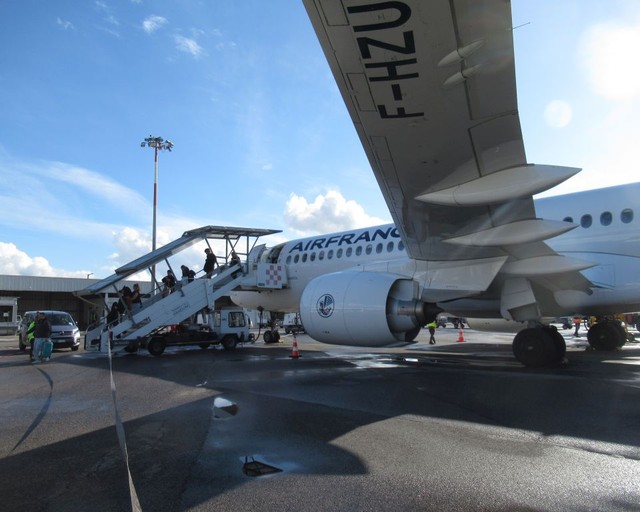


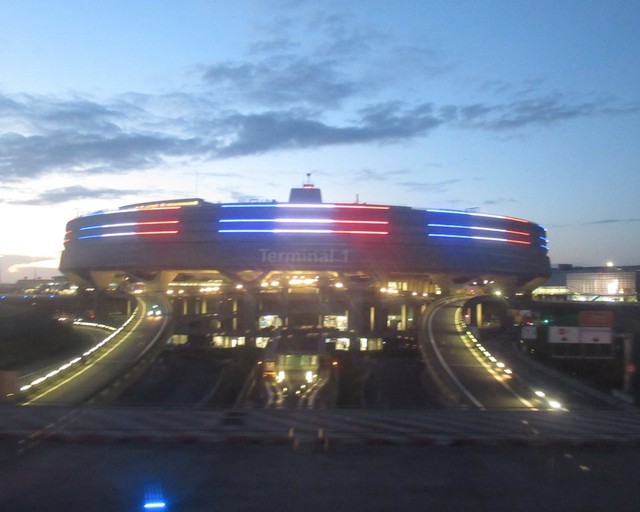
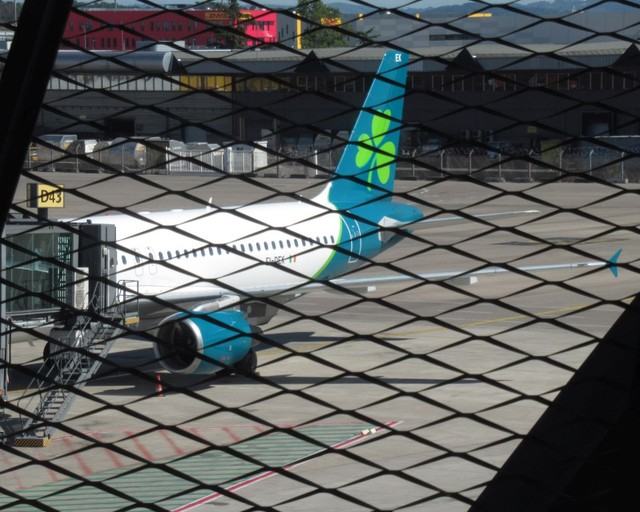

I enjoyed this FR. You have a journalist's approach to observing details that would escape many people's attention.
The musical recommendation is perfect for the workplace. Must be spirit soaring looking at the clouds while listening.
AF has the best catering for Y of any long-haul carrier. The choice of a Champagne owned by the group of growers seems very sensible.
The postage sized-screen is meant to remind pax to bring their own tablets;). The seats are the bring your own gel memory foam cushion next time you travel variety.
Appreciated the time and effort to extend the pleasure of sharing your travel adventures with us Franco-challenged speakers:).
BYOT (Bring your own tablet) indeed : since unlike a growing number of airlines, AF does not provide power ports in economy, a laptop will not do for long haul flights.
Translation is a long exercise, even with cursory proofreading leaving too many typos, and I do appreciate reading that some find it useful. Many thanks for your comment !